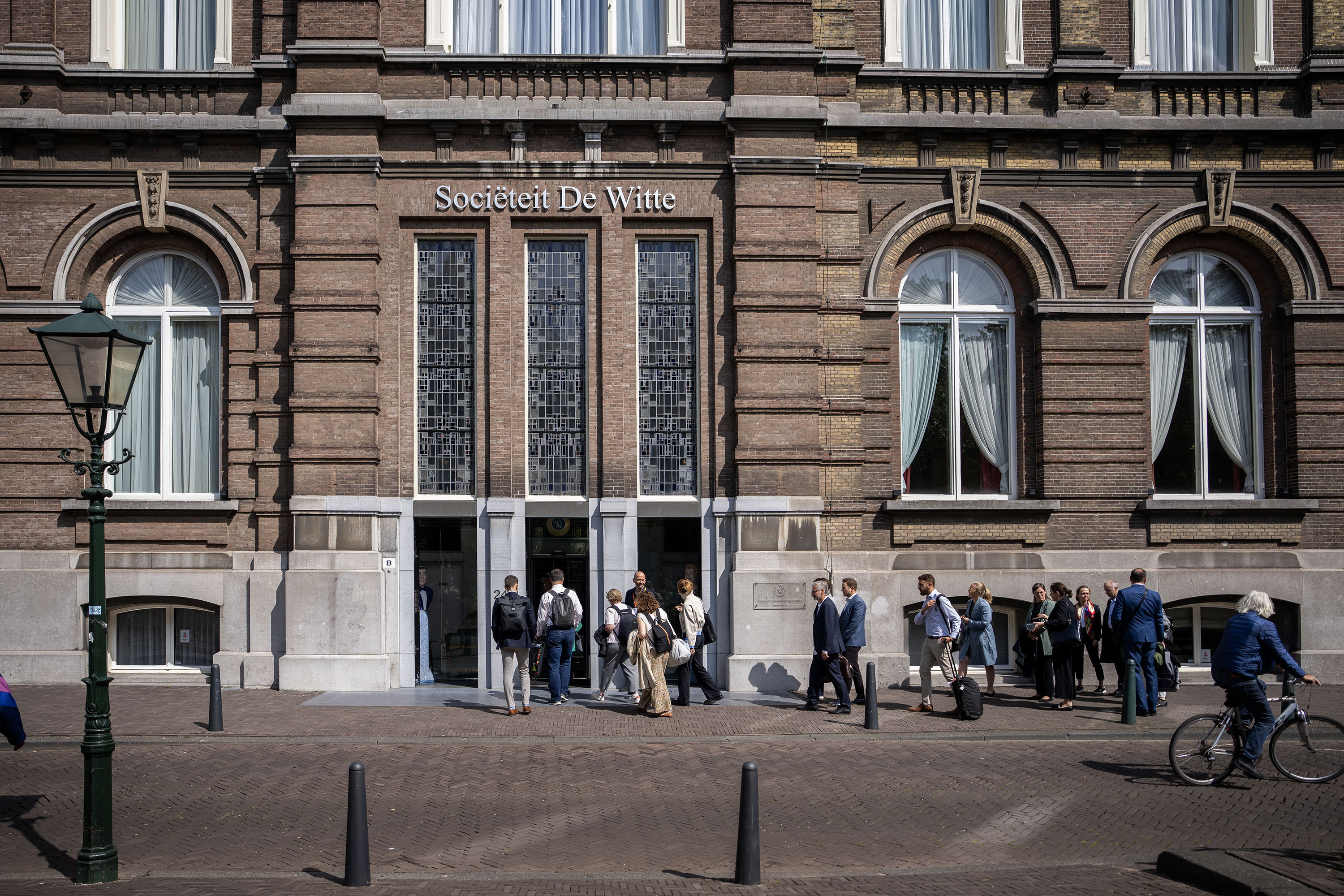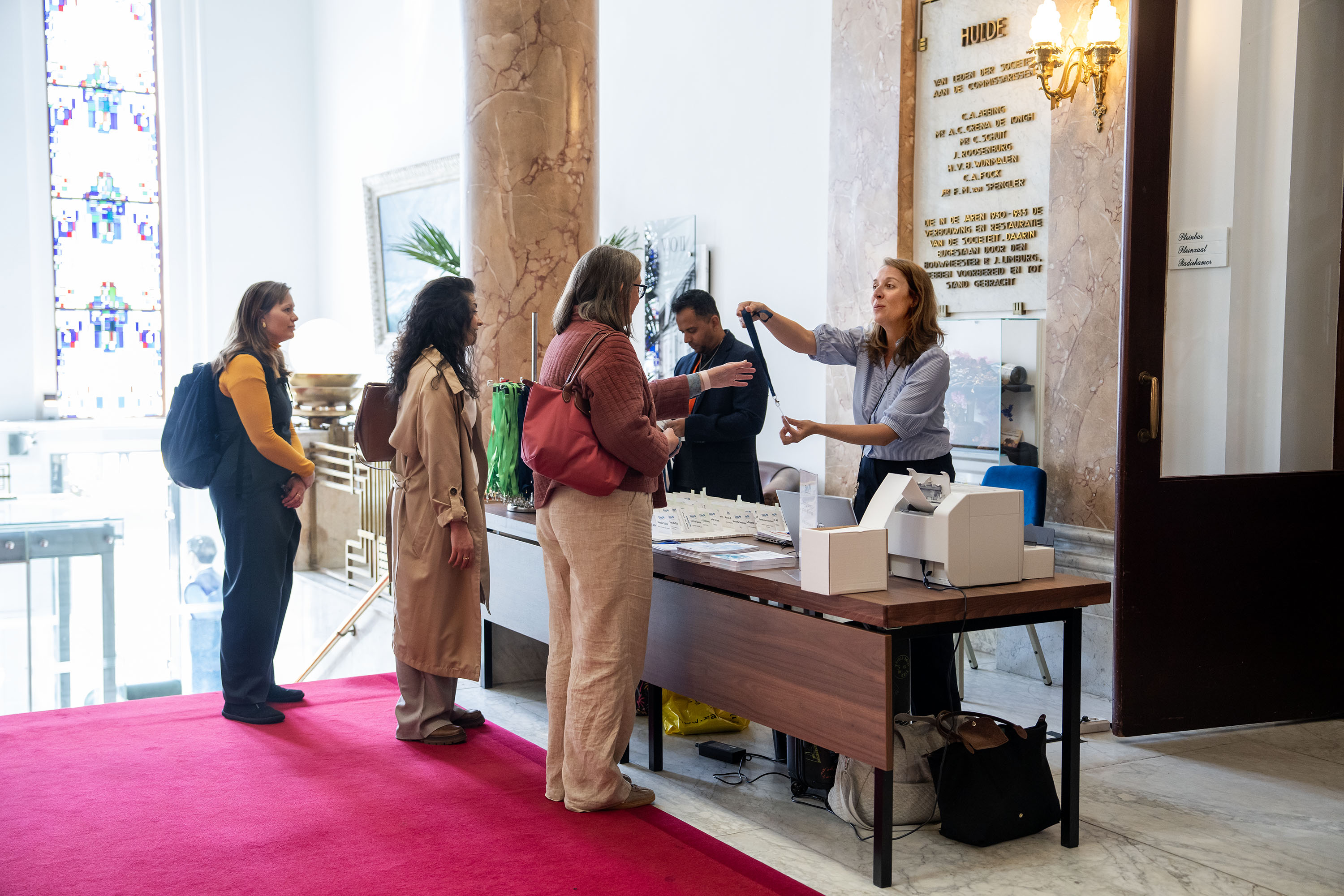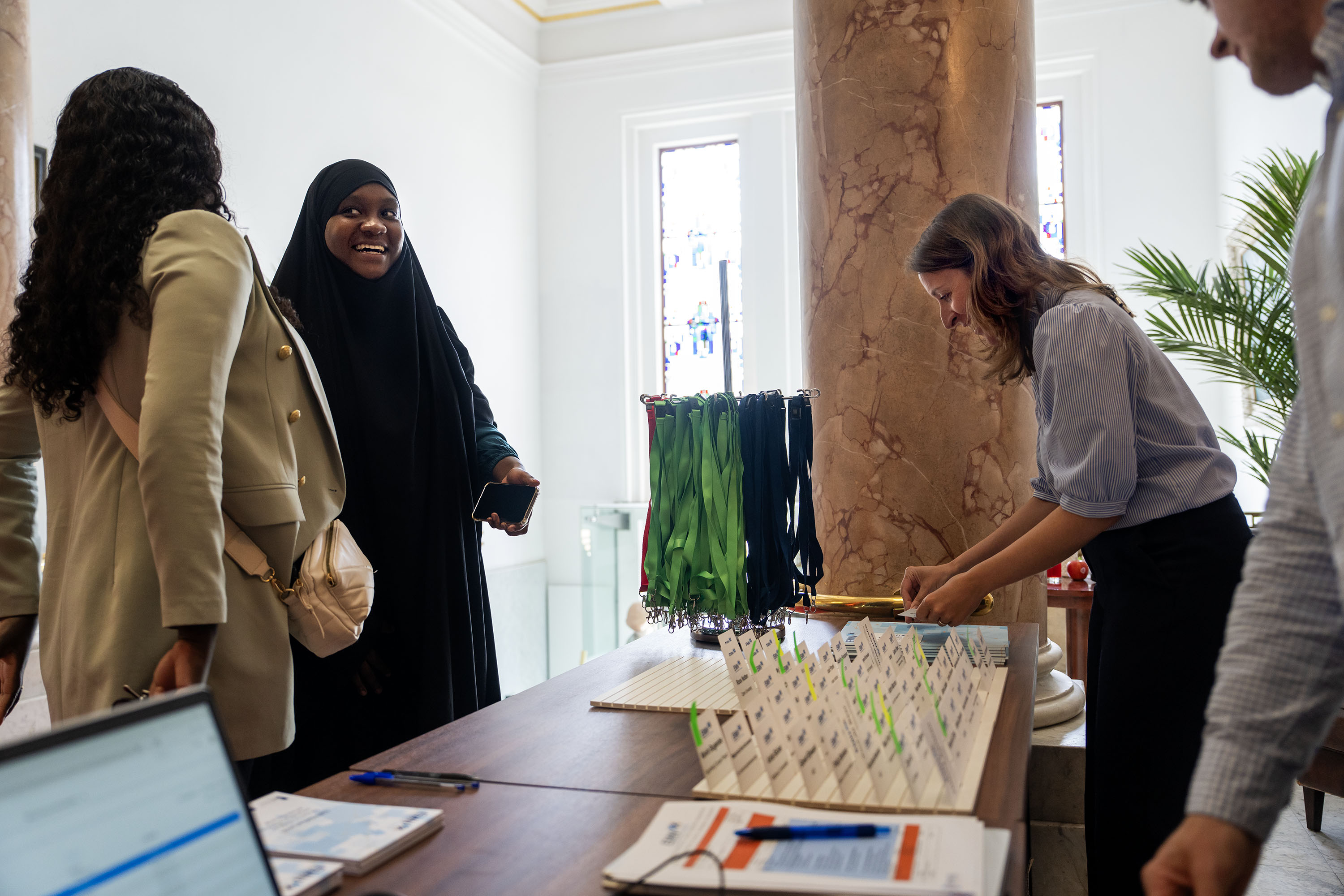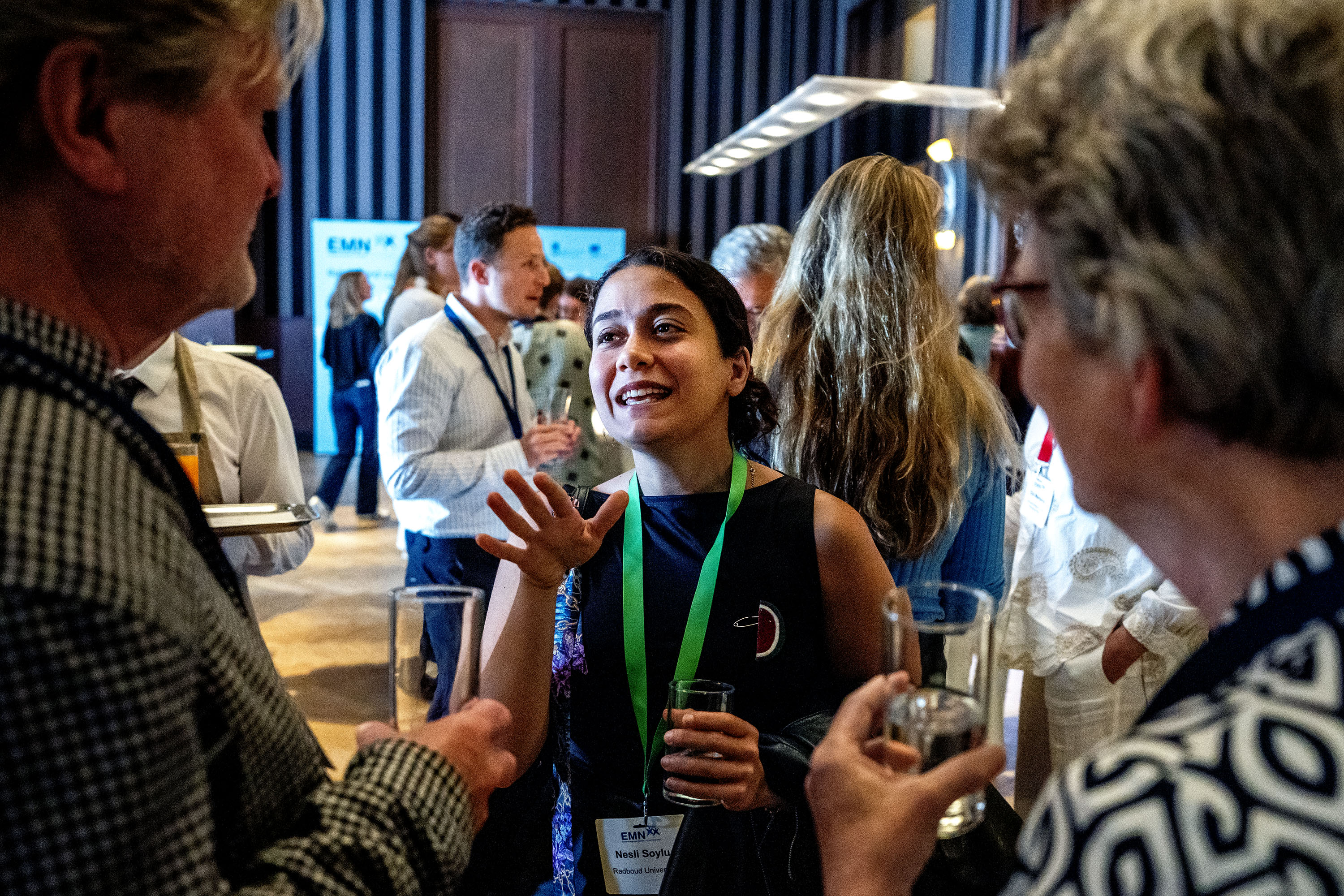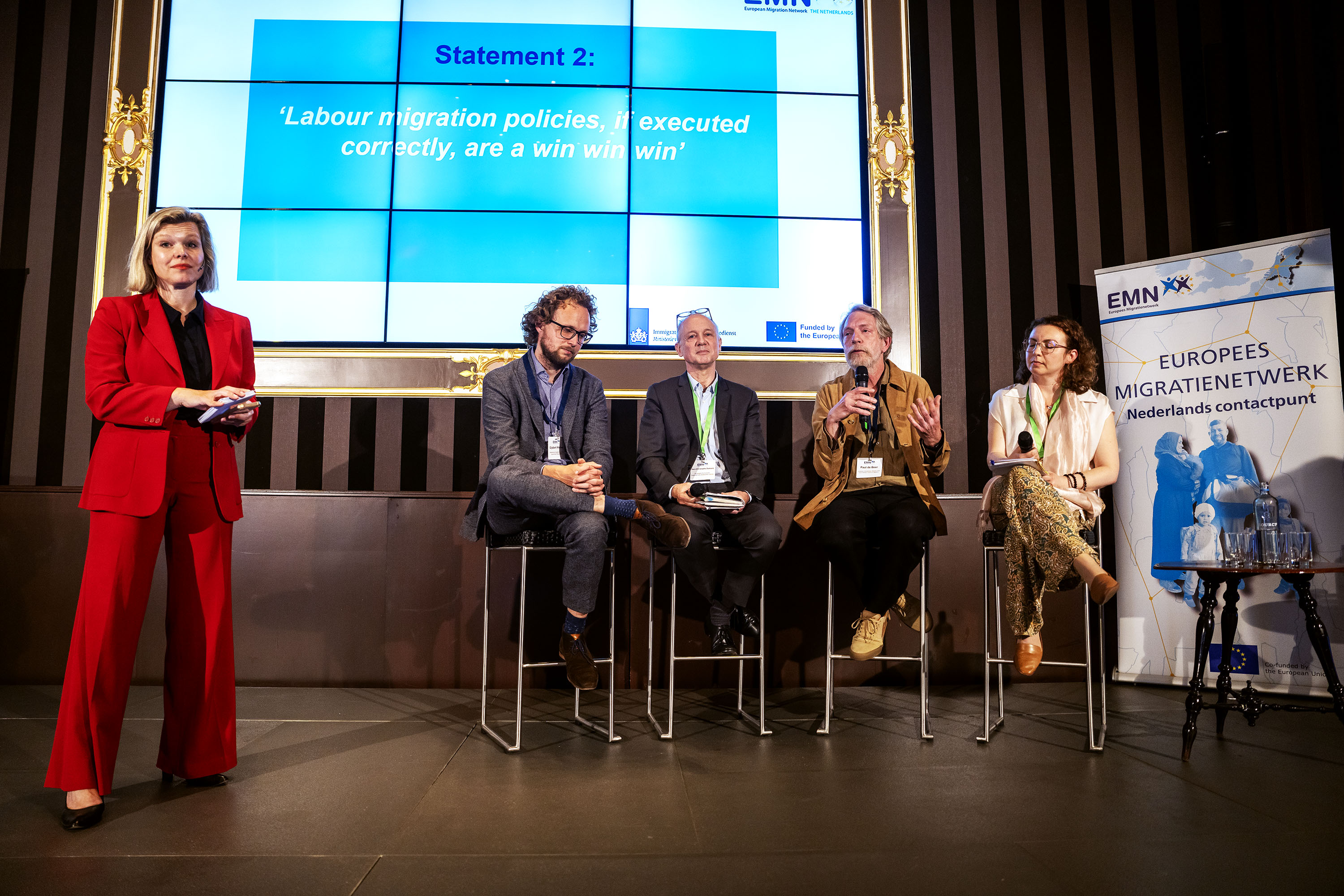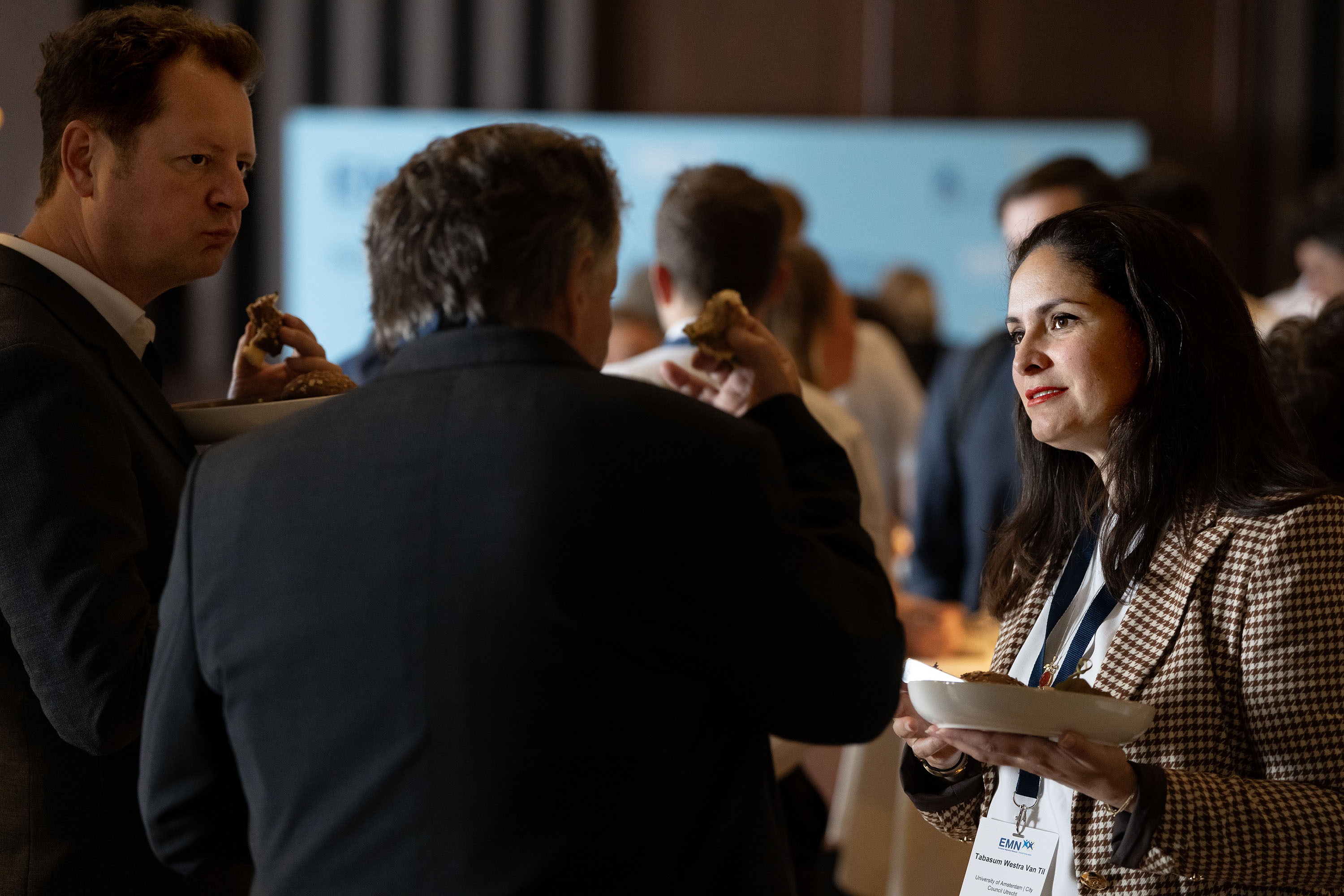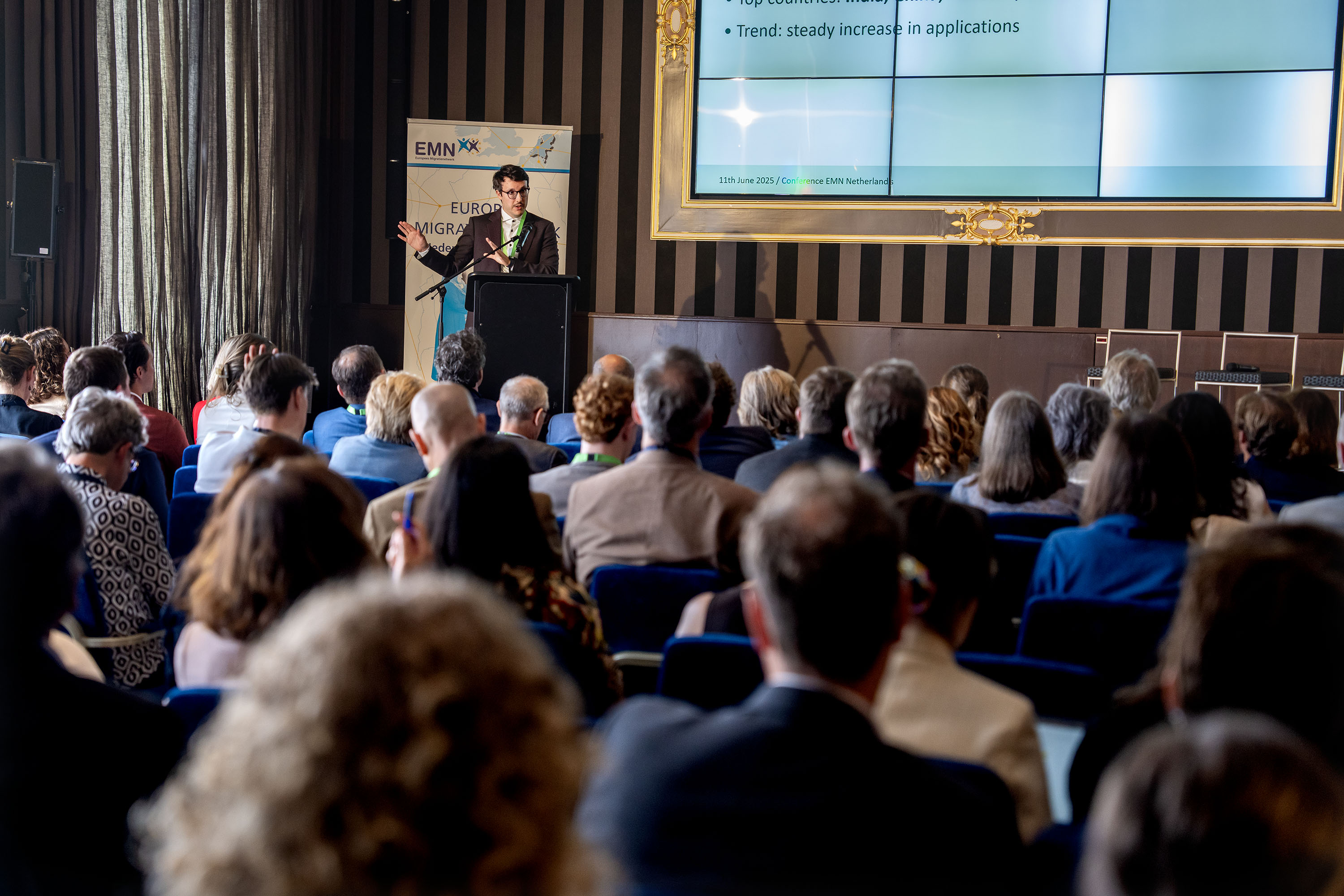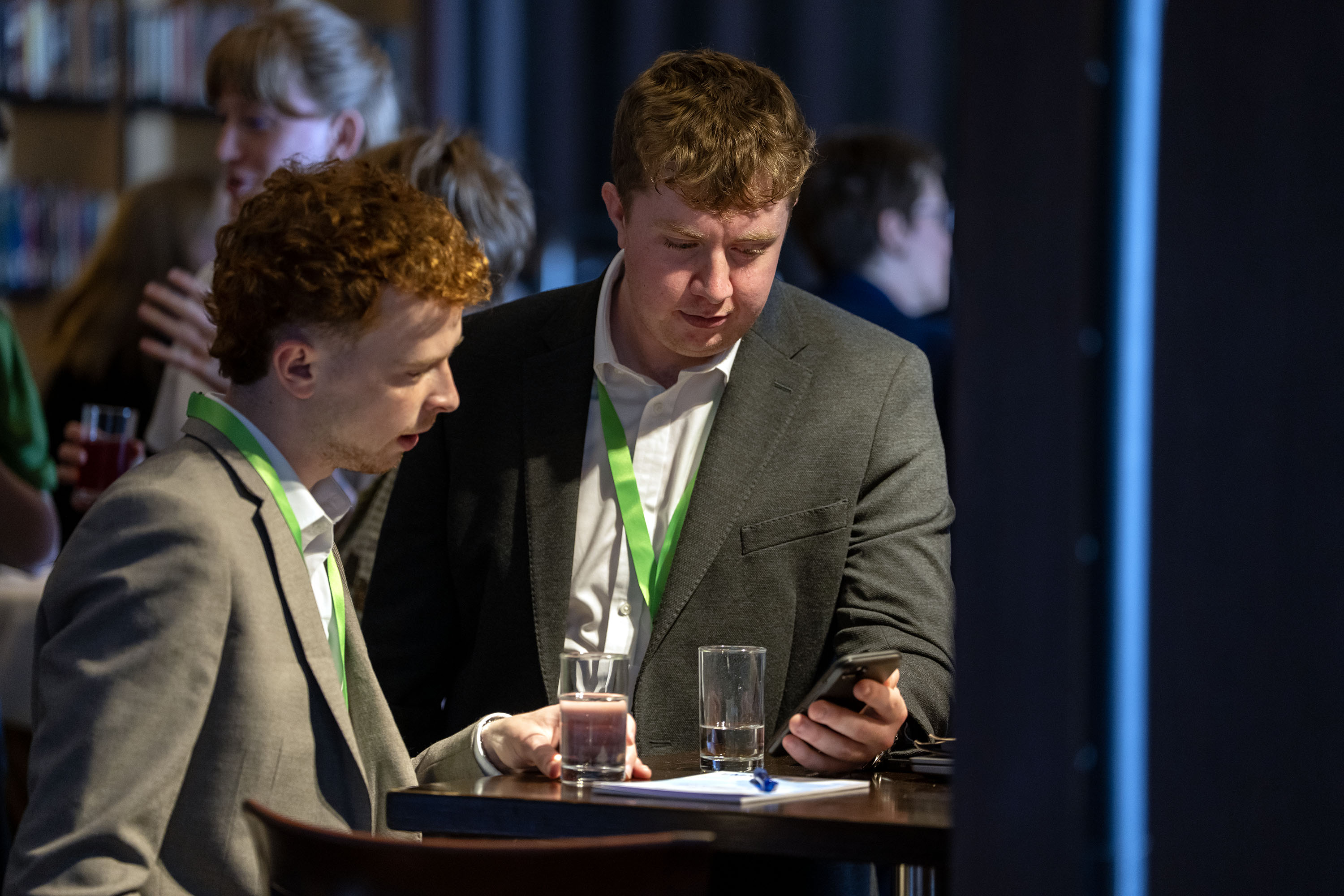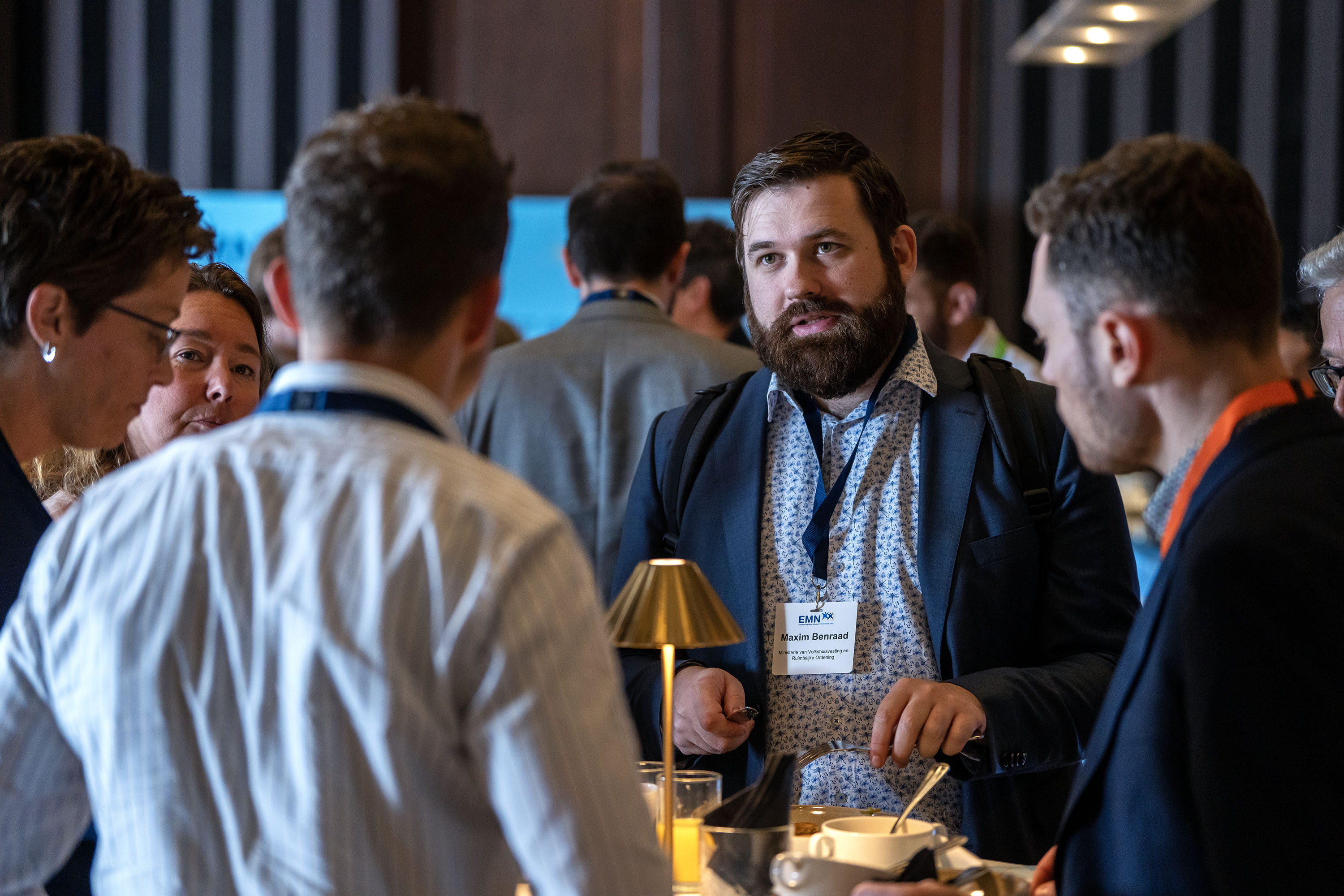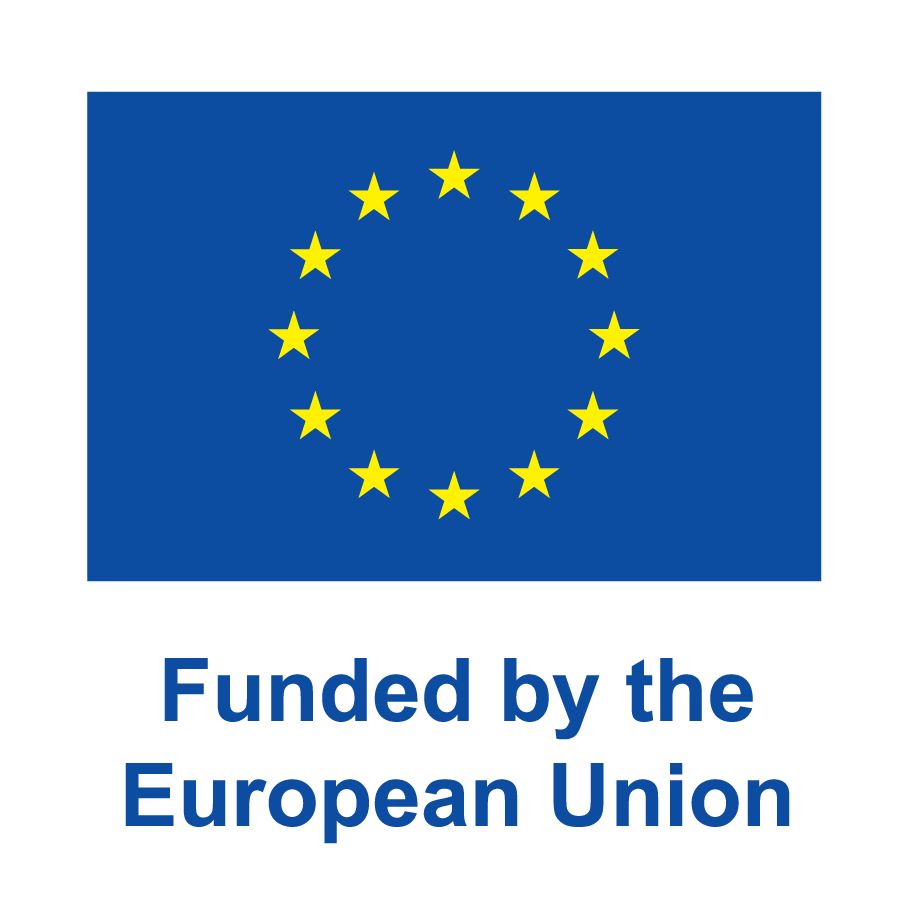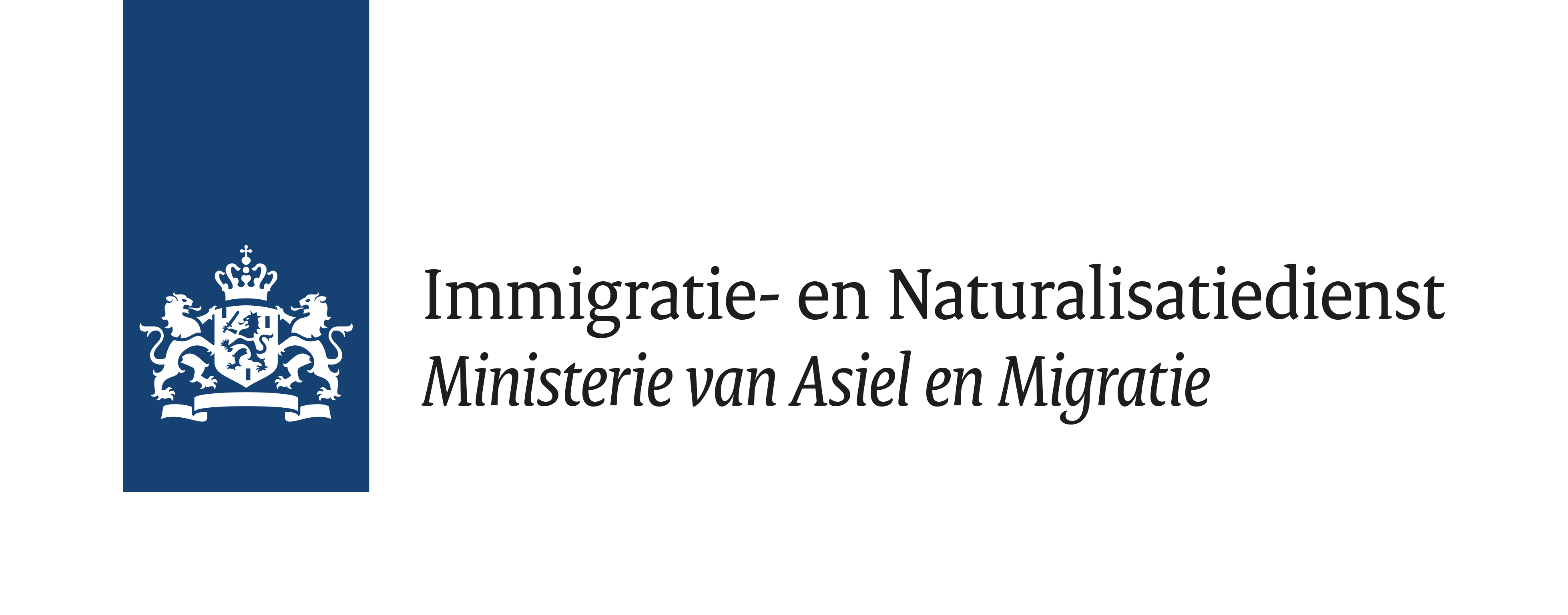
At the 14th edition of the annual conference of EMN Netherlands, national and European experts convened to explore the role labour migration might play in addressing labour market shortages, considering both the benefits and the challenges it brings. Case studies from other EU Member States showed different national approaches to managing labour migration. The dialogue centred around the diverse choices that might shape the future of labour migration policies.
The conference was held at Sociëteit De Witte in The Hague. Over 120 relations attended the event. The audience consisted of a diverse group of practitioners and specialists, including government officials, legal experts, migration professionals, academic researchers and students. Participants from a variety of countries such as Germany, Ireland, Slovakia, Italy, Finland, Greece and more, attended the conference, which was moderated by Desiree Hoving.
Opening
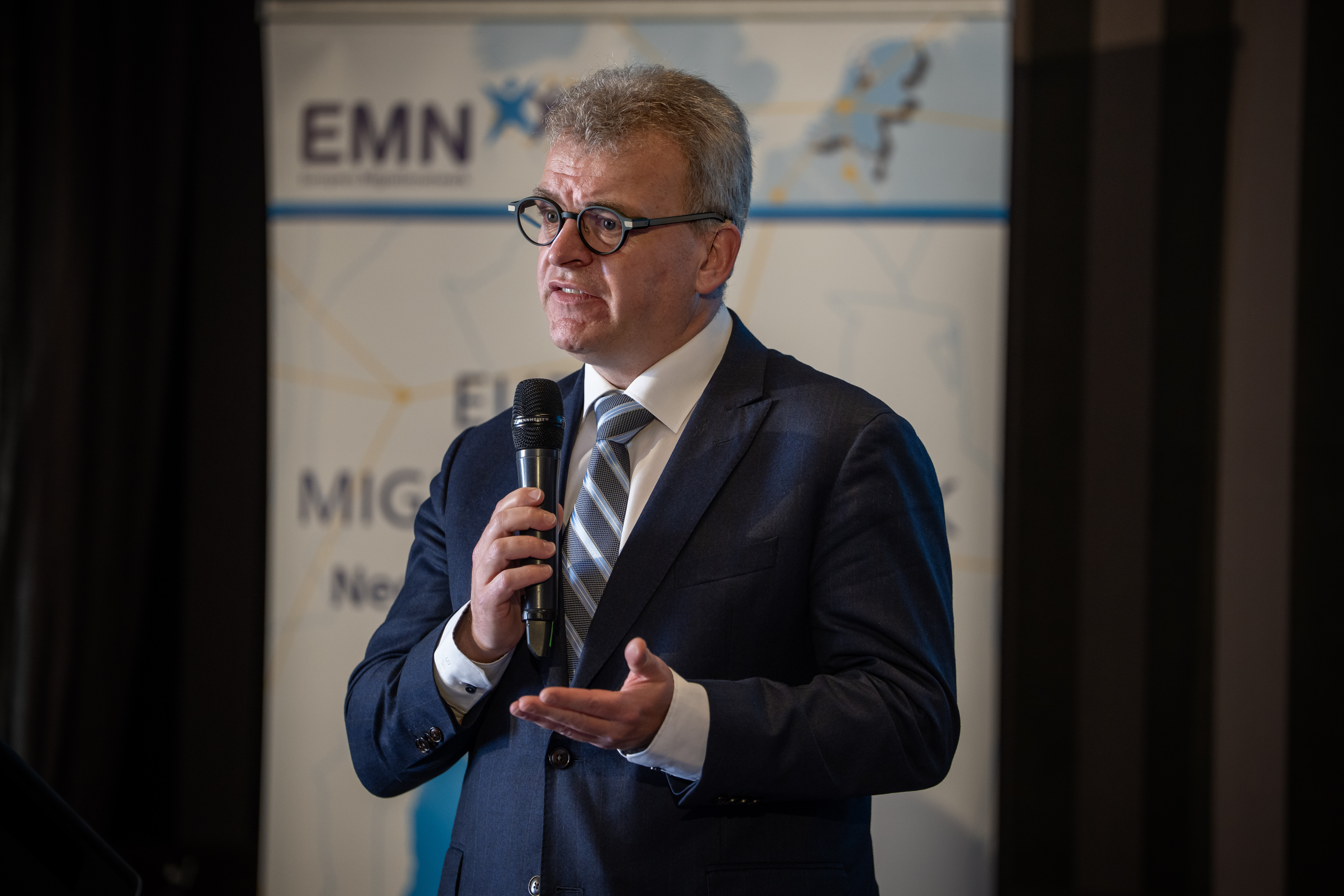
In his opening of the conference Jan Willem Schaper, Deputy Director-General (DG) of Strategy, Implementation Policy and Legal Affairs at the Immigration and Naturalisation Service (IND), stressed the importance of an evidence based conversation about labour migration. ‘It is difficult,’ he said, ‘to ascertain the benefits and costs. But there are benefits. The labour shortages we will face in the not so far away future cannot be solved with labour migration only. But without it, it will be infinitely more difficult.’ Jan Willem Schaper highlighted that, since migration concerns all countries, the diversity of opinion and the joining of expertise at the event, is of great importance.
In her key note speech Kristel van Hees offered, in her role as Deputy Director for Labour Relations at the Dutch Ministry of Social Affairs and Employment, a Dutch perspective on the conference topic. She addressed national challenges such as abuse and exploitation of labour migrants, poor housing conditions and unfair competition and displacement in the labour market, as well as the me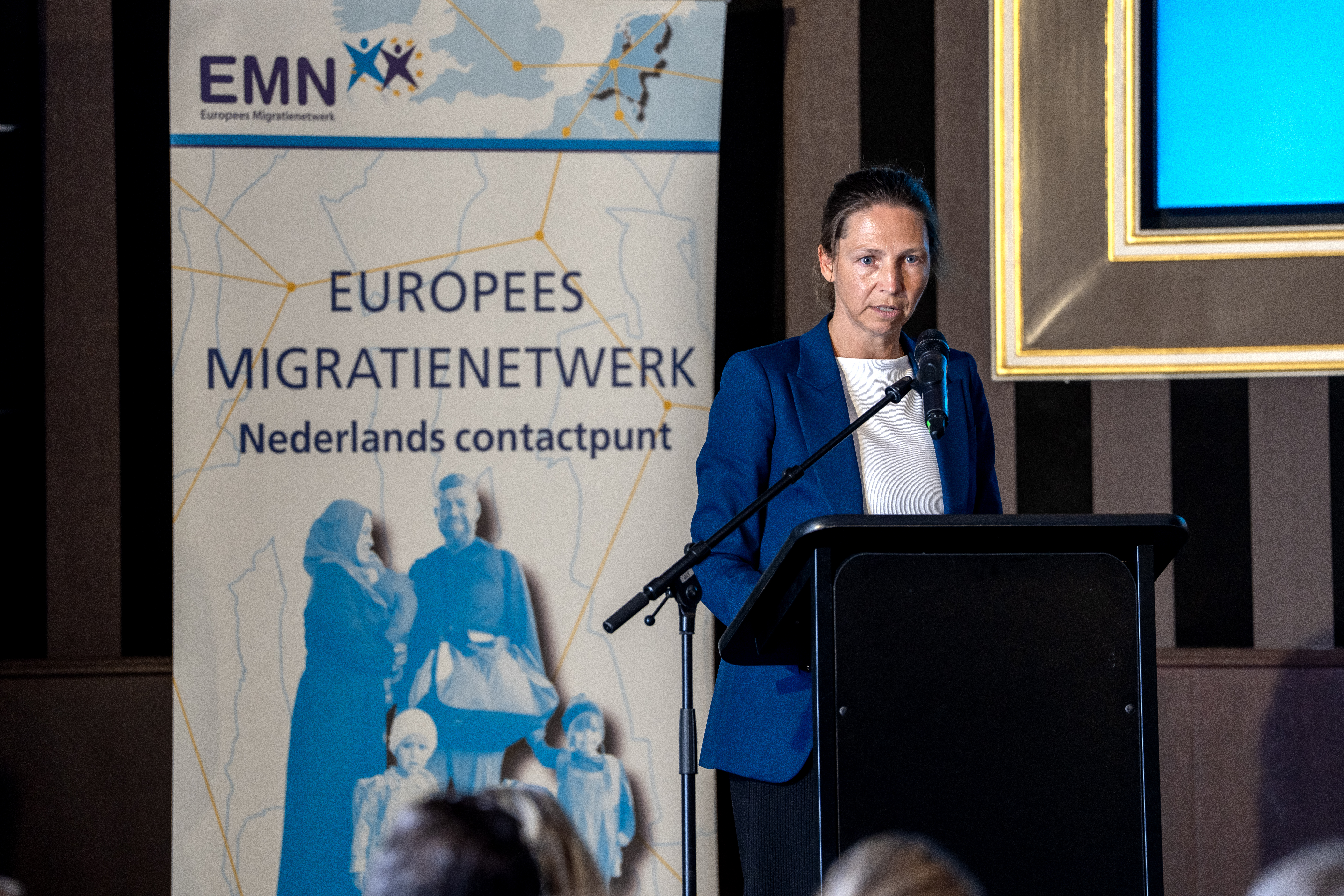 asures that are being taken to combat these challenges. ‘The population growth in the Netherlands in the coming years,’ Kristel van Hees added, ‘mostly driven by labour migration, adds additional pressure on public services like housing, education and care and spatial planning. These issues have gained significant public and political attention and continue to shape our national public debate.’ Considering the European an international dimension of migration, Kristel van Hees highlighted that the Netherlands is ‘not operating in a vacuum. However, the Dutch government does not consider the establishment of partnerships with third countries to be a solution in itself for labour market shortages.’ Kristel van Hees concluded by stating that ‘it is clear that a one-size-fits-all approach to tackling labour market shortages does not suffice. But it is through the important work of the European Migration Network that we can learn from each other, as Member States, since we do face similar challenges.’
asures that are being taken to combat these challenges. ‘The population growth in the Netherlands in the coming years,’ Kristel van Hees added, ‘mostly driven by labour migration, adds additional pressure on public services like housing, education and care and spatial planning. These issues have gained significant public and political attention and continue to shape our national public debate.’ Considering the European an international dimension of migration, Kristel van Hees highlighted that the Netherlands is ‘not operating in a vacuum. However, the Dutch government does not consider the establishment of partnerships with third countries to be a solution in itself for labour market shortages.’ Kristel van Hees concluded by stating that ‘it is clear that a one-size-fits-all approach to tackling labour market shortages does not suffice. But it is through the important work of the European Migration Network that we can learn from each other, as Member States, since we do face similar challenges.’
Presentation EMN research
Hans Lemmens, coordinator of EMN Netherlands, presented the preliminary results of the EMN Study 'Labour migration in times of labour shortages' (study in co-operatio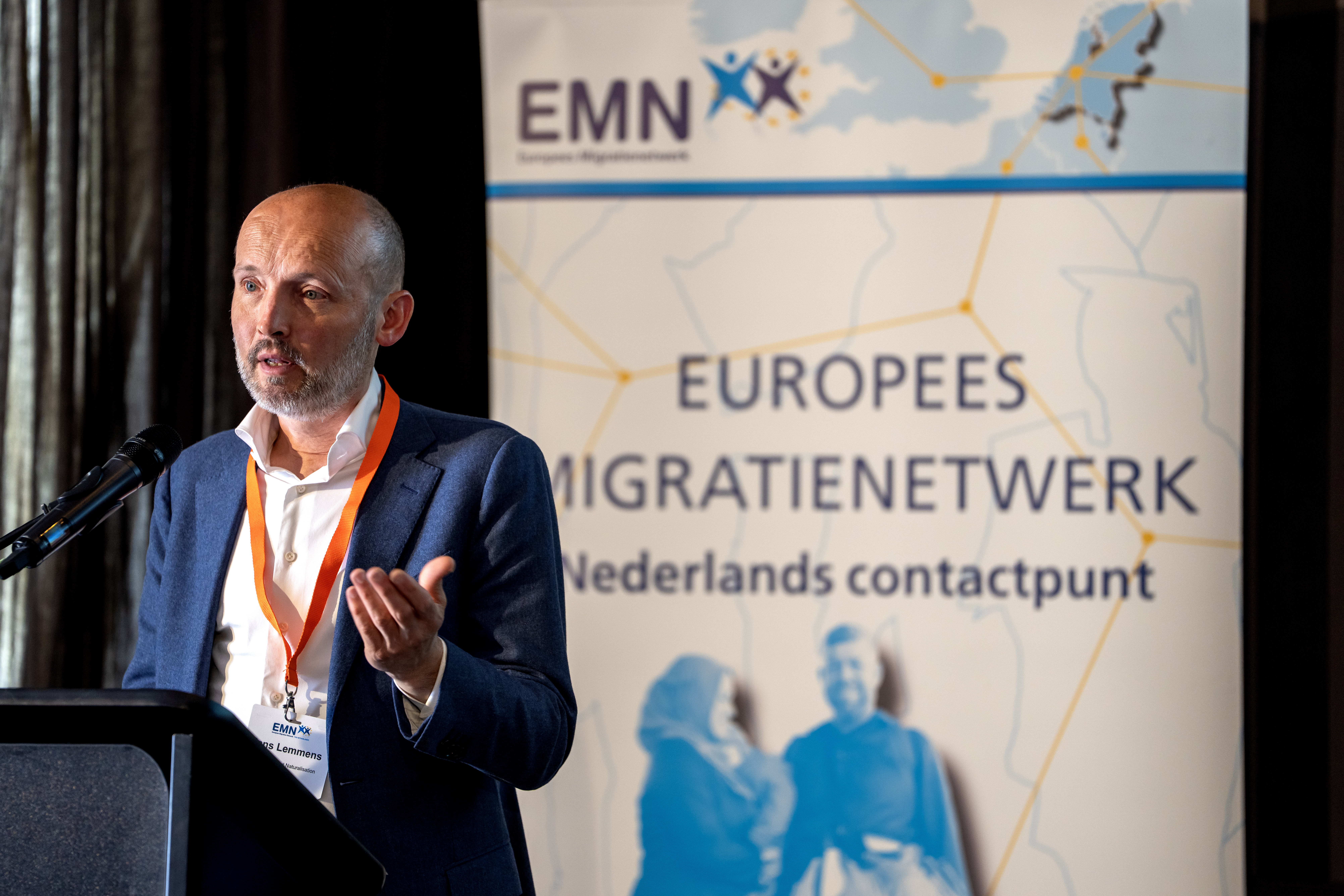 n with the OECD, to be published 26 June). The study showed that labour migration from outside the EU is high on the agenda in all countries. This regards labour migration on all skills levels. The public debate differs per country; whilst in 8 countries there are discussions about the risks and challenges of labour migration, the main concern of the majority (16) of the countries is how to attract labour migrants to address shortages, and how to compete with other EU Member States in this regard. Hans Lemmens continued by showing examples of approaches from different countries, and the instruments commonly used. Among the challenges reported by countries, governance and coordination, lengthy procedures, integration, preventing exploitation, misuse of the system and recognition of foreign qualifications were most frequently mentioned.
n with the OECD, to be published 26 June). The study showed that labour migration from outside the EU is high on the agenda in all countries. This regards labour migration on all skills levels. The public debate differs per country; whilst in 8 countries there are discussions about the risks and challenges of labour migration, the main concern of the majority (16) of the countries is how to attract labour migrants to address shortages, and how to compete with other EU Member States in this regard. Hans Lemmens continued by showing examples of approaches from different countries, and the instruments commonly used. Among the challenges reported by countries, governance and coordination, lengthy procedures, integration, preventing exploitation, misuse of the system and recognition of foreign qualifications were most frequently mentioned.
Case studies from Germany, Finland and Greece
The conference continued with case studies from 3 EU Member States. Pau Palop-García, Political scientist and migration re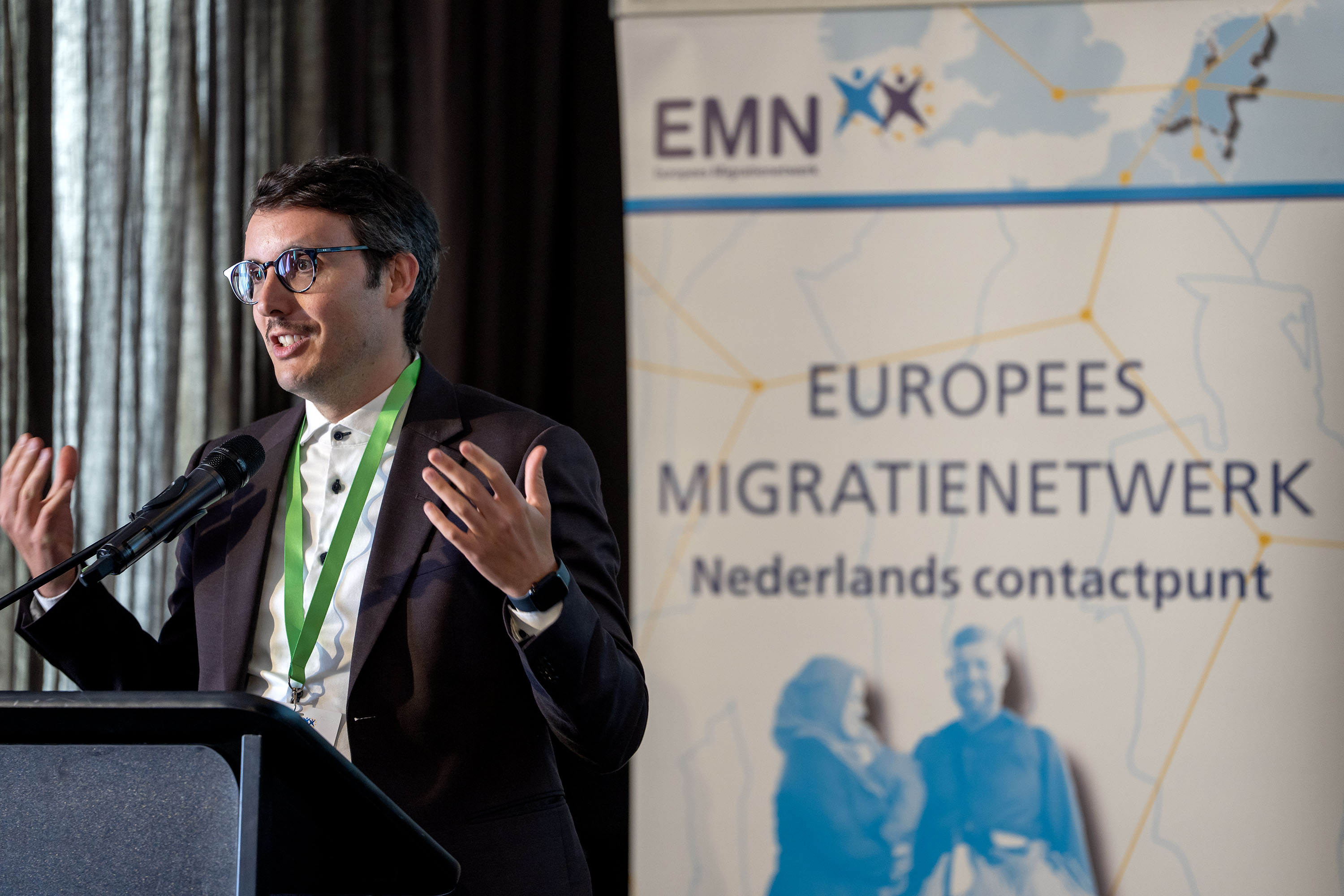 searcher at the German Center for Integration and Migration Research (DeZIM) spoke about the so-called ‘Chancenkarte’. This point based system is a new instrument to manage labour migration in Germany, which is still under evaluation. The card, Pau Palop-García explained, is an attempted solution to a specific problem, which is that Germany needs at least 400.000 people per year to sustain its economy. In order to be eligible for the Chancenkarte, a migrant has to collect 6 points. There are different criteria to get these points (qualifications, work experience, German and/or English language skills, age and whether you have family or other ties to Germany). The card is therefore more flexible than usual migrant permits. Since you don’t need an actual job offer to obtain the card, it enables job seeking. It is too soon, Pau Palop-García stressed, to evaluate properly, but the first results are showing an increase in applications, also from unexpected countries. There are, however, still some key challenges that have to be dealt with, such as the complexity of the rules and the difficulty migrants experience in finding a job that matches their qualificati
searcher at the German Center for Integration and Migration Research (DeZIM) spoke about the so-called ‘Chancenkarte’. This point based system is a new instrument to manage labour migration in Germany, which is still under evaluation. The card, Pau Palop-García explained, is an attempted solution to a specific problem, which is that Germany needs at least 400.000 people per year to sustain its economy. In order to be eligible for the Chancenkarte, a migrant has to collect 6 points. There are different criteria to get these points (qualifications, work experience, German and/or English language skills, age and whether you have family or other ties to Germany). The card is therefore more flexible than usual migrant permits. Since you don’t need an actual job offer to obtain the card, it enables job seeking. It is too soon, Pau Palop-García stressed, to evaluate properly, but the first results are showing an increase in applications, also from unexpected countries. There are, however, still some key challenges that have to be dealt with, such as the complexity of the rules and the difficulty migrants experience in finding a job that matches their qualificati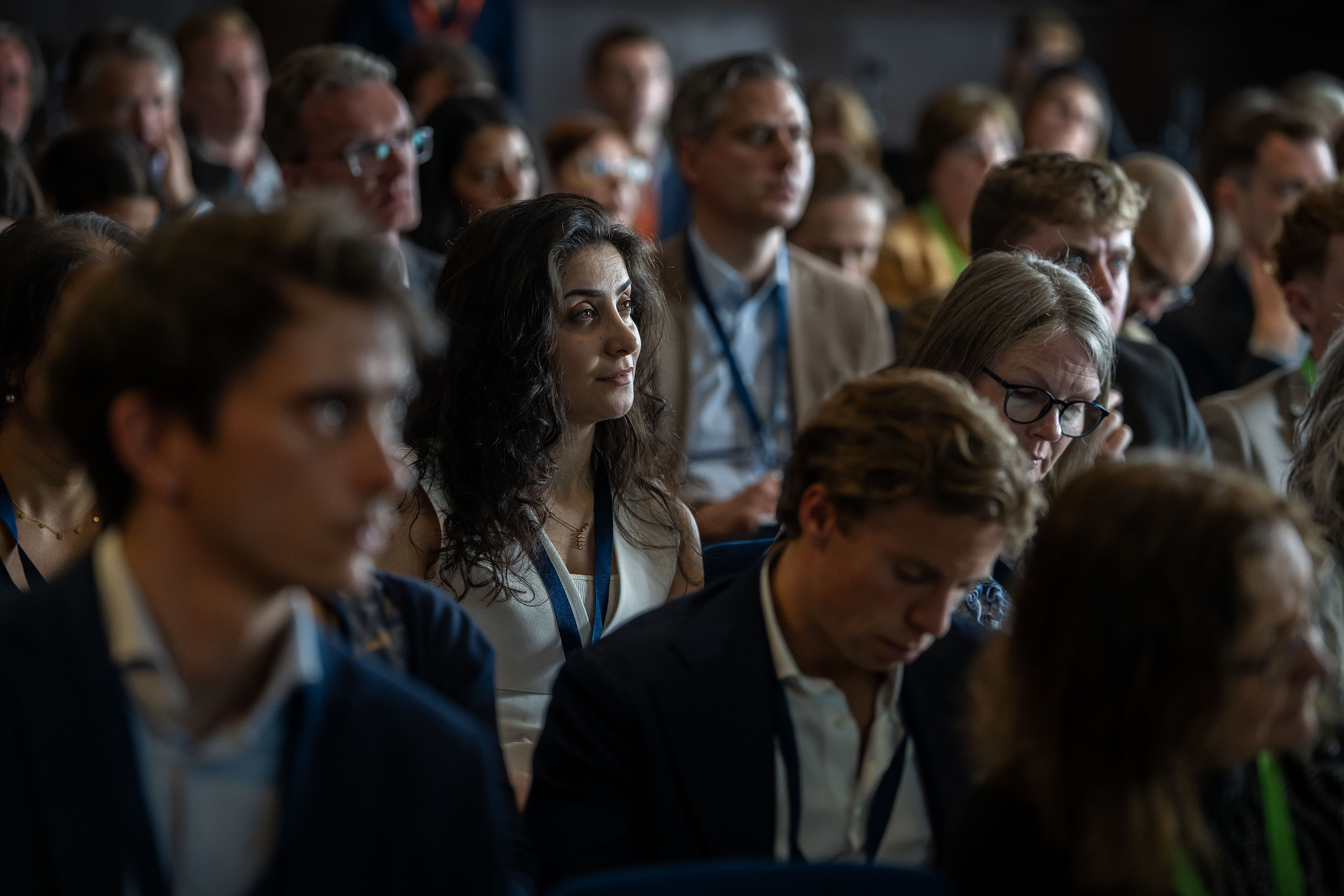 ons. The preliminary results allow for some recommendations, such as extending of the permit duration beyond 12 months, increasing points for specific shortage occupations, improving data tracking and monitoring, providing support for migrants in finding a house, a job, etc, and responsibly engaging private recruiters (brokers).
ons. The preliminary results allow for some recommendations, such as extending of the permit duration beyond 12 months, increasing points for specific shortage occupations, improving data tracking and monitoring, providing support for migrants in finding a house, a job, etc, and responsibly engaging private recruiters (brokers).
Barbara Bergbom, Chief specialist at the Finnish Institute of Occupational Health (FIOH), followed by giving a presentation about the (ongoing) project ‘Recruiting from abroad and employee retention in the healthcare and social services sector’, of which she is the coordinator. Barbara Bergbom explained that Finland is a fast aging country, in need of (mostly) practical and professional nurses. The aim of FIOH’s project is to identify existing best practices within three public health organizations, each of which has individually started pilot projects on recruiting nurses from abroad, and to explore new approaches to support workplace inclusion. The aim of these pilot projects is not only to address current shortages but also to develop the skills and knowledge needed to recruit larger numbers of labor migrants 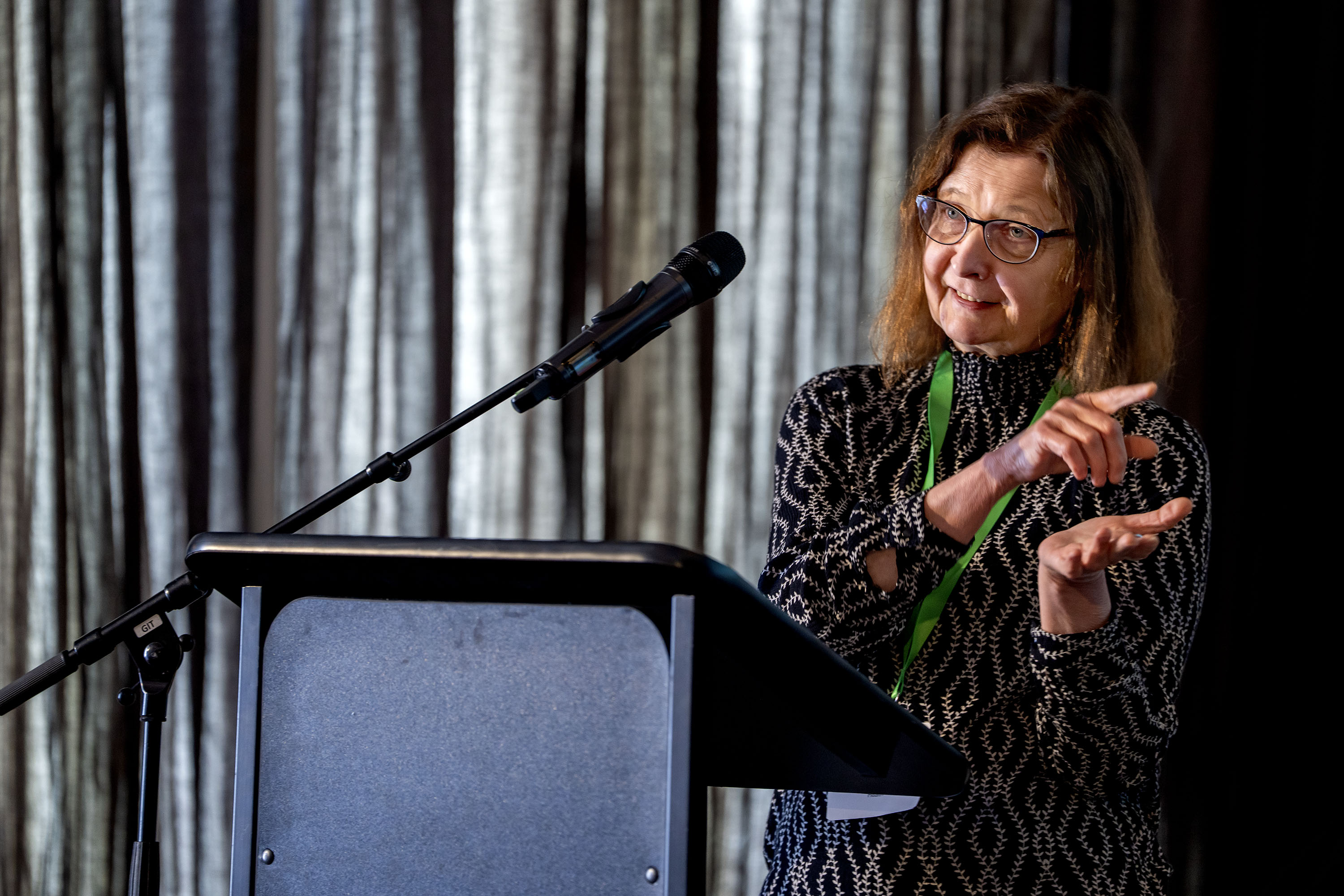 in the future. The recruits in the project are all of Philippine descent and mostly professional nurses. The recruitment companies used by the health organizations arrange 6 to 9 months of pre-departure training for recruit candidates, which includes basic Finnish language studies and several language tests. If they succeed, they must still pass a Finnish language test equivalent to A2 level before travelling to Finland. When the migrants come to Finland, they usually start with on the job education (working 4 days a week and spending 1 day on further education). As the project is ongoing, it is too soon to evaluate properly. However, Barbara Bergbom mentioned that there is a clear gap when it comes to social inclusion. Research shows that his is crucial for employee wellbeing. Migrants have a much more higher risk of social exclusion. ‘Our practical goal is to develop a model that support organizations in assisting with the integration process of internationally recruited nursed into their work and work community,’ Barbara Bergbom stated.
in the future. The recruits in the project are all of Philippine descent and mostly professional nurses. The recruitment companies used by the health organizations arrange 6 to 9 months of pre-departure training for recruit candidates, which includes basic Finnish language studies and several language tests. If they succeed, they must still pass a Finnish language test equivalent to A2 level before travelling to Finland. When the migrants come to Finland, they usually start with on the job education (working 4 days a week and spending 1 day on further education). As the project is ongoing, it is too soon to evaluate properly. However, Barbara Bergbom mentioned that there is a clear gap when it comes to social inclusion. Research shows that his is crucial for employee wellbeing. Migrants have a much more higher risk of social exclusion. ‘Our practical goal is to develop a model that support organizations in assisting with the integration process of internationally recruited nursed into their work and work community,’ Barbara Bergbom stated.
Theodora Stathopoulou, Head of Department for labour migration and equal opportunities at the Greek Ministry of Labour and Social Security, presented her country’s circular migration model for seasonal migrants. Labour market shortages are high in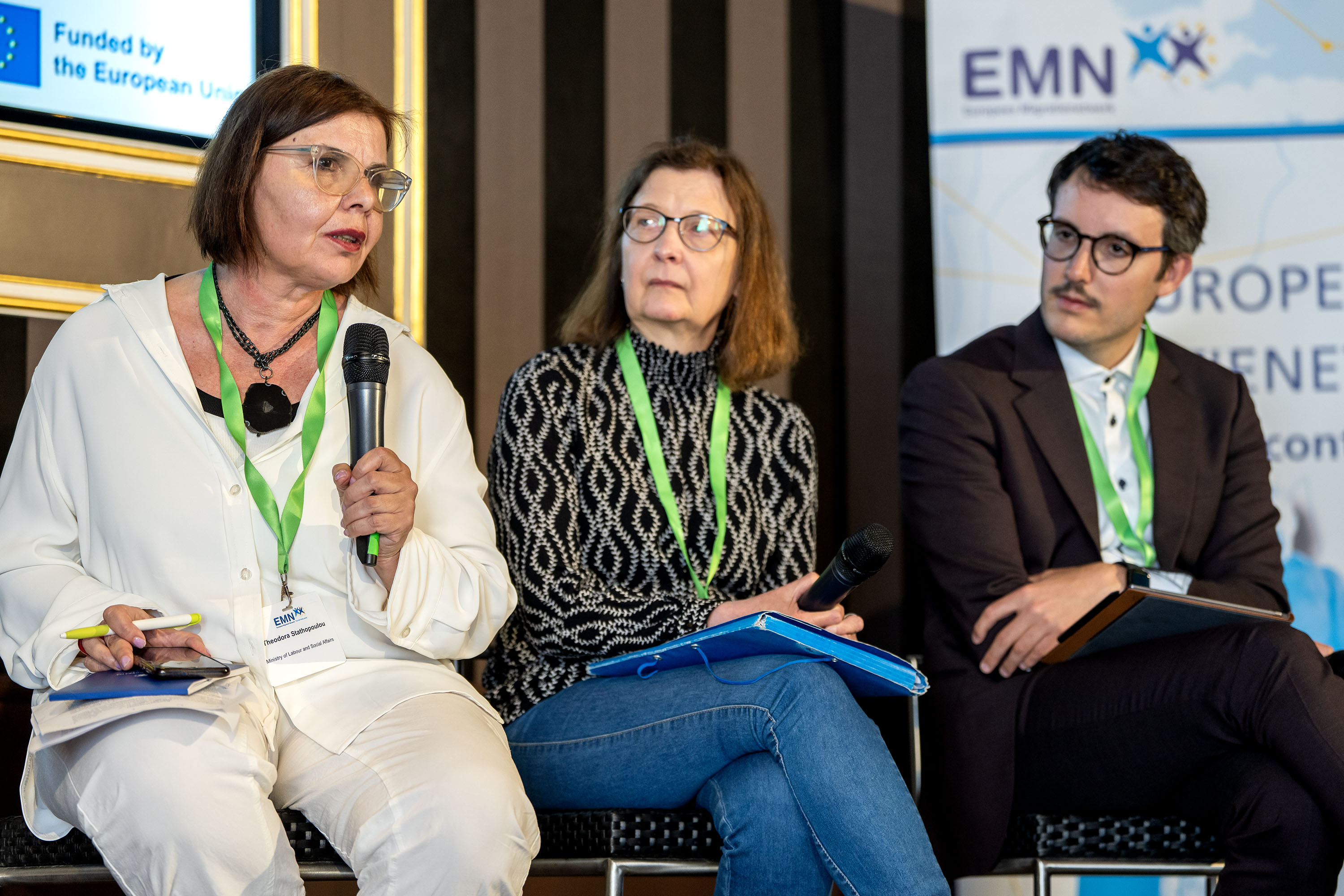 Greece, she stated, especially in agriculture, construction, tourism, manufacturing and care services. Statistics show a continued increase of demand in Greece. To address this problem Greece has signed bilateral agreements with both Bangladesh and Egypt. These agreements focus mainly on seasonal work and on the agricultural sector. Theodora Stathopoulou continued by mentioning some of the risks involved, such as too much dependency on third country nationals, exploitation and abuse, and challenges such as language barriers and lack of knowledge, amongst migrants, of their rights and of procedures. Theodora Stathopoulou concluded by stressing that social standards of employment should be guaranteed and recruitment has to be respectful.
Greece, she stated, especially in agriculture, construction, tourism, manufacturing and care services. Statistics show a continued increase of demand in Greece. To address this problem Greece has signed bilateral agreements with both Bangladesh and Egypt. These agreements focus mainly on seasonal work and on the agricultural sector. Theodora Stathopoulou continued by mentioning some of the risks involved, such as too much dependency on third country nationals, exploitation and abuse, and challenges such as language barriers and lack of knowledge, amongst migrants, of their rights and of procedures. Theodora Stathopoulou concluded by stressing that social standards of employment should be guaranteed and recruitment has to be respectful.
After the presentations, the audience responded with a variety of questions for all speakers. A question was raised about the social side of labour migration, which is often overlooked. How can we change the fact that we look at labour migration purely from an economic point of view? Barbara Bergbom stressed that social inclusion and equity are important and that the mindset is slowly changing but more is needed. In Germany, Pau Palop-Garcia answered, the control of entry debate is not integrated with the integration citizenship debates. All these stages of migration should be considered from the get-go.
Another comment from the audience concerned the popular support for labour migration, which is lacking in the Netherlands. A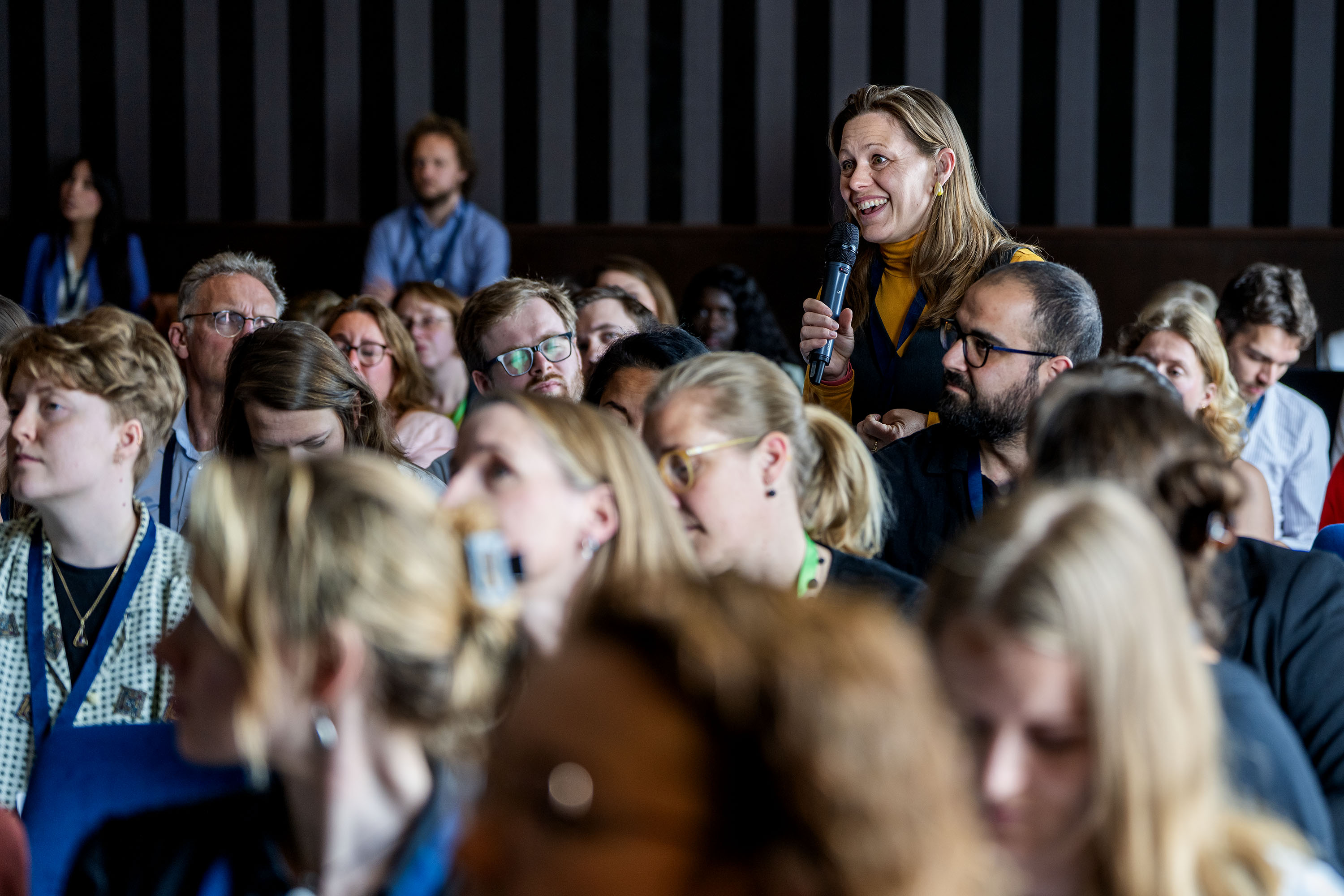 question was posed at all speakers about what their countries are doing to promote public support. Barbara Bergbom answered that Finland has a government lead programme to increase the receptiveness of Finnish society, and to improve knowledge about cultural diversity. Pau Palop-Garcia stressed that Germany needs to accept that it is a migrant country. But politicians and media in Germany instead push for the ‘migration is a problem’ message.
question was posed at all speakers about what their countries are doing to promote public support. Barbara Bergbom answered that Finland has a government lead programme to increase the receptiveness of Finnish society, and to improve knowledge about cultural diversity. Pau Palop-Garcia stressed that Germany needs to accept that it is a migrant country. But politicians and media in Germany instead push for the ‘migration is a problem’ message.
Interactive session: ‘Stakeholders’ perspectives - practical considerations and experiences’
Desiree Hoving opened the next interactive session by introducing Jules Wouters, Policy advisor labour migration at the Netherlands Trade Union Confederation (FNV), and Imre Vellenga, Director Corporate Social Responsibility at AgroCare. AgroCare is one on of the largest tomato growers in Europe, and depends strongly on labour migration. Via a poll the order of the topics these two speakers would discuss was decided by the audience.
The first topic chosen, was ‘labour migration as a sustainable and long-term solution’. Jules Wouters mentioned agriculture, con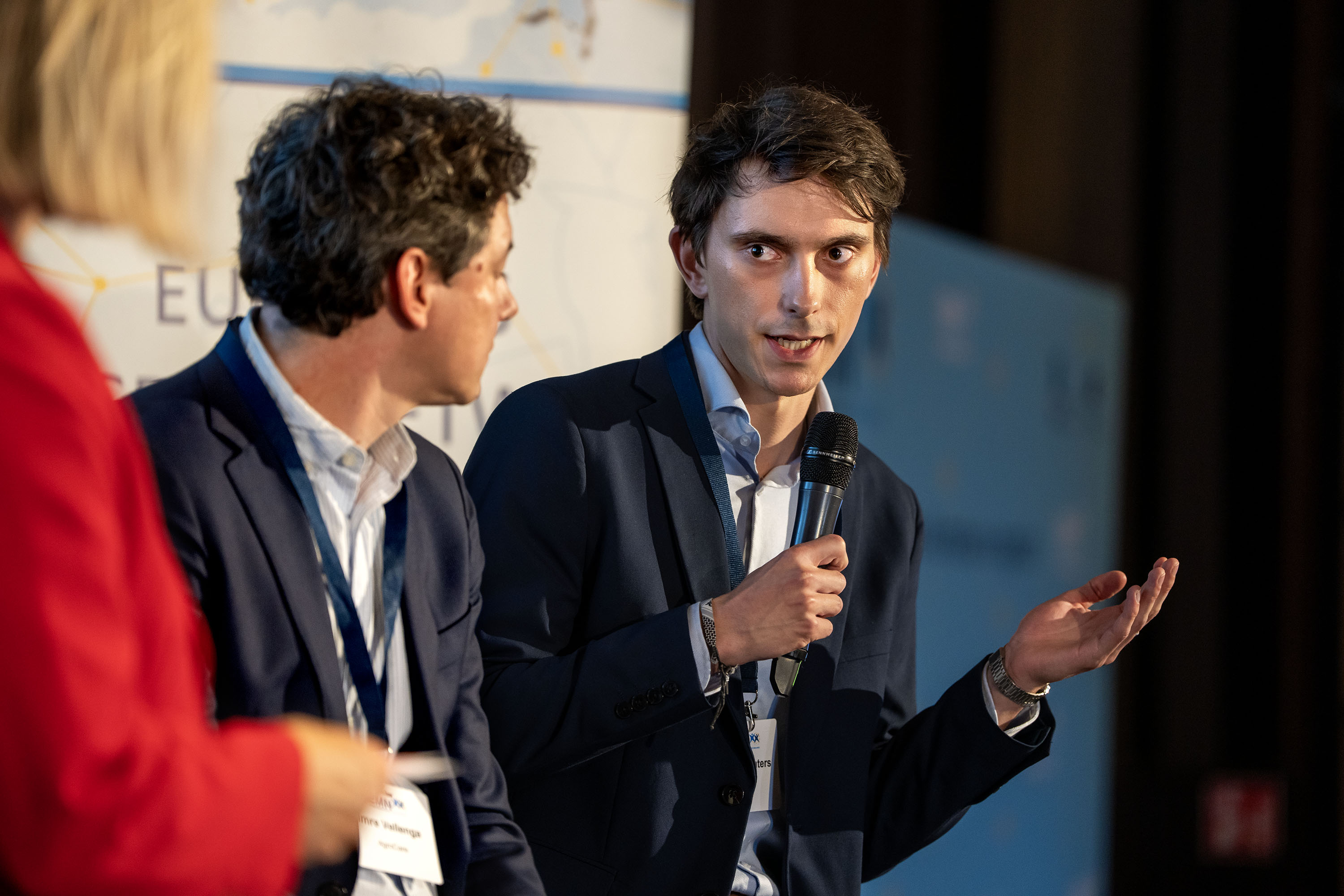 struction, transport and logistics and meat processing as sectors that are more or less dependent on labour migrants. These are mostly lower paid sectors, he added. For the FNV proper working conditions are the our main concern. ‘We are a wealthy country. But we still see a lot of exploitation.’ Imre Vellenga agreed that ‘we should care for our people and ensure the right working conditions.’ When asked about seasonal and temporary work forms for permanent labour needs in the Dutch economy, Jules Wouters stressed the importance of distinguishing between temporary and seasonal work. ‘Some companies have 70-80 percent temporary contracts. Over half of the labour migrants have these contracts. These are temporary contracts for permanent jobs. Most migrants do hard work, but have less rights. Seasonal workers are also very often used by employers to ‘circulate’ as much migrants as they can. Because if they are only here for a short time, they don’t complain and they don’t build up any rights. Very often the terms are used by employers to keep migrants on the most precarious contracts.’
struction, transport and logistics and meat processing as sectors that are more or less dependent on labour migrants. These are mostly lower paid sectors, he added. For the FNV proper working conditions are the our main concern. ‘We are a wealthy country. But we still see a lot of exploitation.’ Imre Vellenga agreed that ‘we should care for our people and ensure the right working conditions.’ When asked about seasonal and temporary work forms for permanent labour needs in the Dutch economy, Jules Wouters stressed the importance of distinguishing between temporary and seasonal work. ‘Some companies have 70-80 percent temporary contracts. Over half of the labour migrants have these contracts. These are temporary contracts for permanent jobs. Most migrants do hard work, but have less rights. Seasonal workers are also very often used by employers to ‘circulate’ as much migrants as they can. Because if they are only here for a short time, they don’t complain and they don’t build up any rights. Very often the terms are used by employers to keep migrants on the most precarious contracts.’
When asked about the integration of labour migrants into the workplace, and the role of employers in this process, Jules Wouters mentioned that temporary contracts also mean less access to training, language courses, e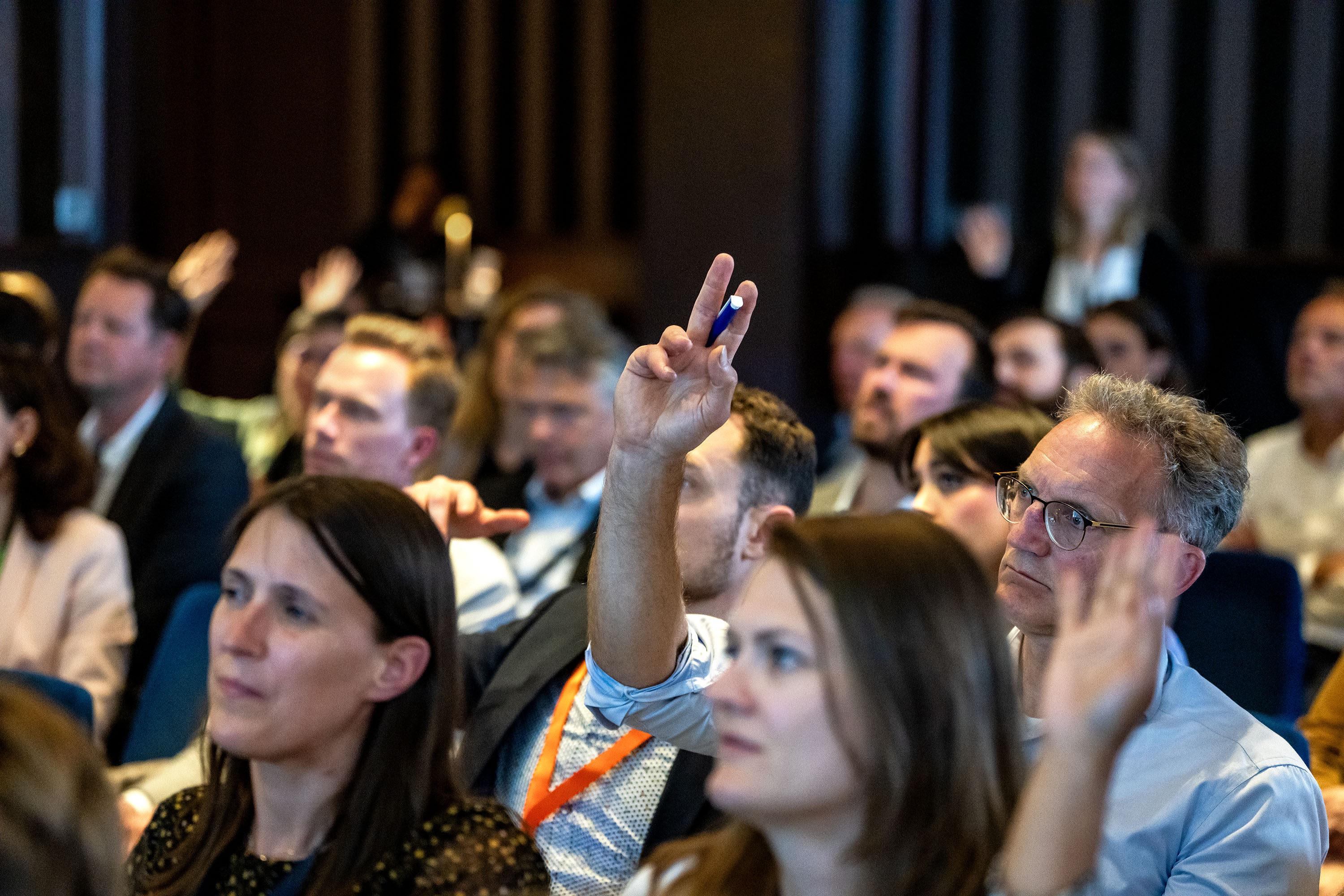 tc. Physically demanding jobs, irregular shifts and long commutes means there is little time to integrate. Imre Vellenga added that employers are partly responsible. ‘At AgroCare we provide language lessons, etc. But some people come only to spend a summer abroad and there is little integration. The responsibility of the employer is at the work space, but also facilitating that migrants are not limited outside work.’ Jules Wouers responded that ‘fortunately many employers do feel the responsibility. But not everywhere. Unfortunately the situation is often very bad. A lot of migrants are taking pain killers just to be able to keep doing their work. They get fired easily, and end up on the street. It is totally unacceptable. But obviously the government also has a responsibility. Our labour inspection could do a lot to improve, that is also internationally recognized.’
tc. Physically demanding jobs, irregular shifts and long commutes means there is little time to integrate. Imre Vellenga added that employers are partly responsible. ‘At AgroCare we provide language lessons, etc. But some people come only to spend a summer abroad and there is little integration. The responsibility of the employer is at the work space, but also facilitating that migrants are not limited outside work.’ Jules Wouers responded that ‘fortunately many employers do feel the responsibility. But not everywhere. Unfortunately the situation is often very bad. A lot of migrants are taking pain killers just to be able to keep doing their work. They get fired easily, and end up on the street. It is totally unacceptable. But obviously the government also has a responsibility. Our labour inspection could do a lot to improve, that is also internationally recognized.’
When asked whether the current policy mechanisms set in place by the Dutch government are sufficient to protect migrant workers, Jules Wouters answered no. ‘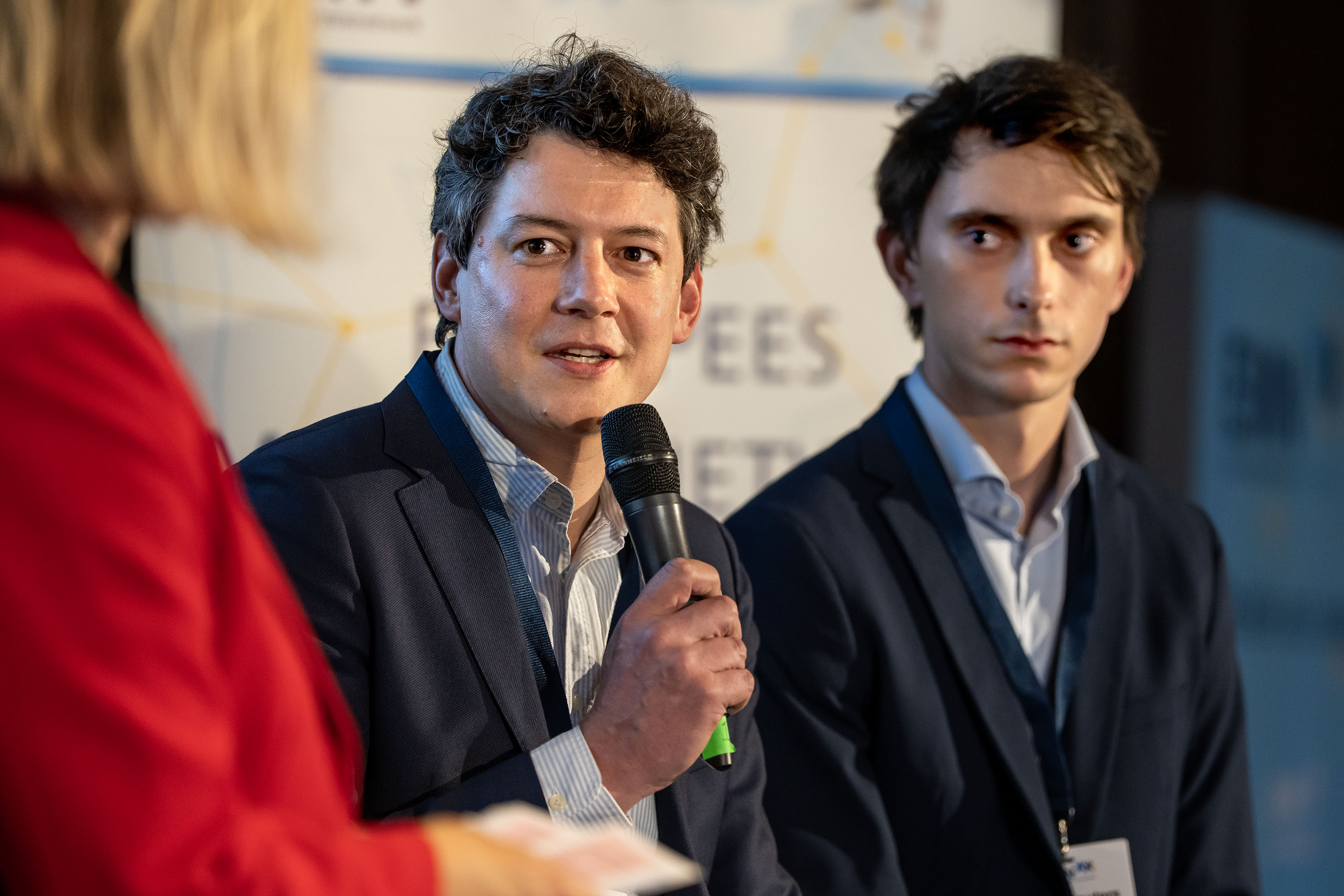 What we see as a union, is that the debate is old, but nothing is changing and things are actually getting worse. Many of the problems were signalled when I was still in primary school. There is really a lack of urgency. We need to be courageous and take strong measures. But I am not optimistic.’
What we see as a union, is that the debate is old, but nothing is changing and things are actually getting worse. Many of the problems were signalled when I was still in primary school. There is really a lack of urgency. We need to be courageous and take strong measures. But I am not optimistic.’
One of the remarks from the audience concerned minimum wage: labour migrants are ‘just too cheap’, if minimum wages go up, the companies have to change. This would benefit everybody. Imre Vellenga agreed: ‘Yes, why not, minimum wages can go up. But only if this goes for everyone.’ Jules Wouters said he was ‘surprised’, since this is not often mentioned as a solution. ‘But it is also good for the economy. Indeed companies are addicted to cheap labour. This is a very easy button to press.’
Expert panel
The panel discussion was opened by Desiree Hoving, who introduced guest speakers Jean-Christophe Dumont, Head of the International Migration Division at the Directorate for Employment, Labour and Social Affairs of the OECD, Telma Brito Martins, Legal and policy officer at DG HOME Unit C2 of the European Commission, Gijsbert Werner, Senior researcher and project leader at the Netherlands Scientific Council for Government Policy (WRR) and Paul de Beer, Emeritus professor of industrial re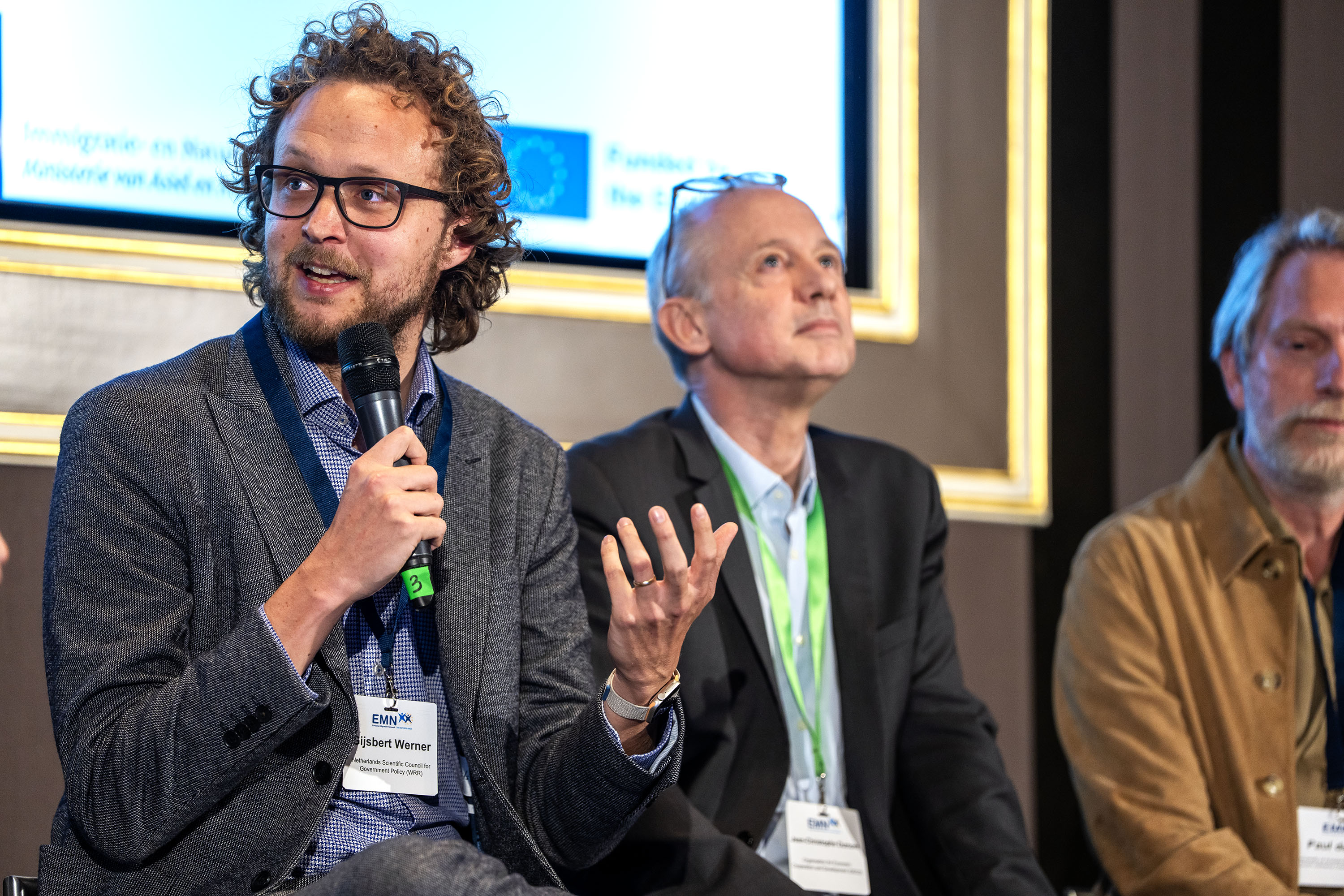 lations at the University of Amsterdam and member of the Dutch Advisory Council on Migration. Three statements were posed, on which the speakers were asked to respond or share their views.
lations at the University of Amsterdam and member of the Dutch Advisory Council on Migration. Three statements were posed, on which the speakers were asked to respond or share their views.
1| The EU and its Member States need labour migration in order to maintain economically competitive, even if that will lead to pressure on social services (such as housing, education, healthcare) and to pressure on the social cohesion of local communities.
‘We have to consider the demographic situation across Europe,’ Gijsbert Werner said. ‘Our expectation is that the Netherlands will change focus to the first part of the statement (i.e. that we need labour migration for economic reasons, red). We are currently concerned mostly with ‘keeping them out’, but we will shift more towards attracting labour migration in the future. This is a shift we are already observing in other EU-countries, many of which are ahead of the Netherlands in terms of decline of the labour force and population ageing’ Jean-Christophe Dumont also saw ‘the logic in cutting the sentence (of the statement, red) in two,’ but stressed that ‘the issues are linked.’ He said ‘it is not realistic that we will meet all the labour market demands through labour migration. We must also make better use of the existing work force. There is a lot to gain in the Netherlands in this respect. It’s not about numbers, it’s all about skills. The difficulty is to have a flexible education training system to adapt to the changing labour market.’ Paul de Beer agreed that ‘skills are crucial.’ He added that there are different types of shortage. ‘First, there is the unemployed in the Netherlands who don’t want the jobs. Second, for technical skills, for example at ASML or in healthcare, there are insufficient people. There labour migration has a role to play. But for the first type it only creates bad conditions.’ Telma Brito Martins said that ‘we have to look beyond the apparent opposition in the statement. We have to look at it from EU point of view. To remain economically competitive we need a skilled workforce. Maximizing domestic work force is not sufficient, so we must work on attracting talent from abroad and promoting the legal pathways. The EU has put in place various initiatives to achieve these goals, which need to be seen in coherence and adapted to the different Member States and their realities.’
2| Labour migration policies, if executed correctly, are a win win win.
Paul de Beer explained that ‘win win win’ in this case means there are three parties to consider when we talk about labour migration. The country of origin, the migrant and country of reception. ‘They could all gain,’ he said. ‘Labour migration means people can go to the place where their talents are needed. Everyone could benefit – also the country of origine, because they might have less unemployment). But as they say, there is no such thing as a free lunch. If you benefit, you also lose something. Higher educa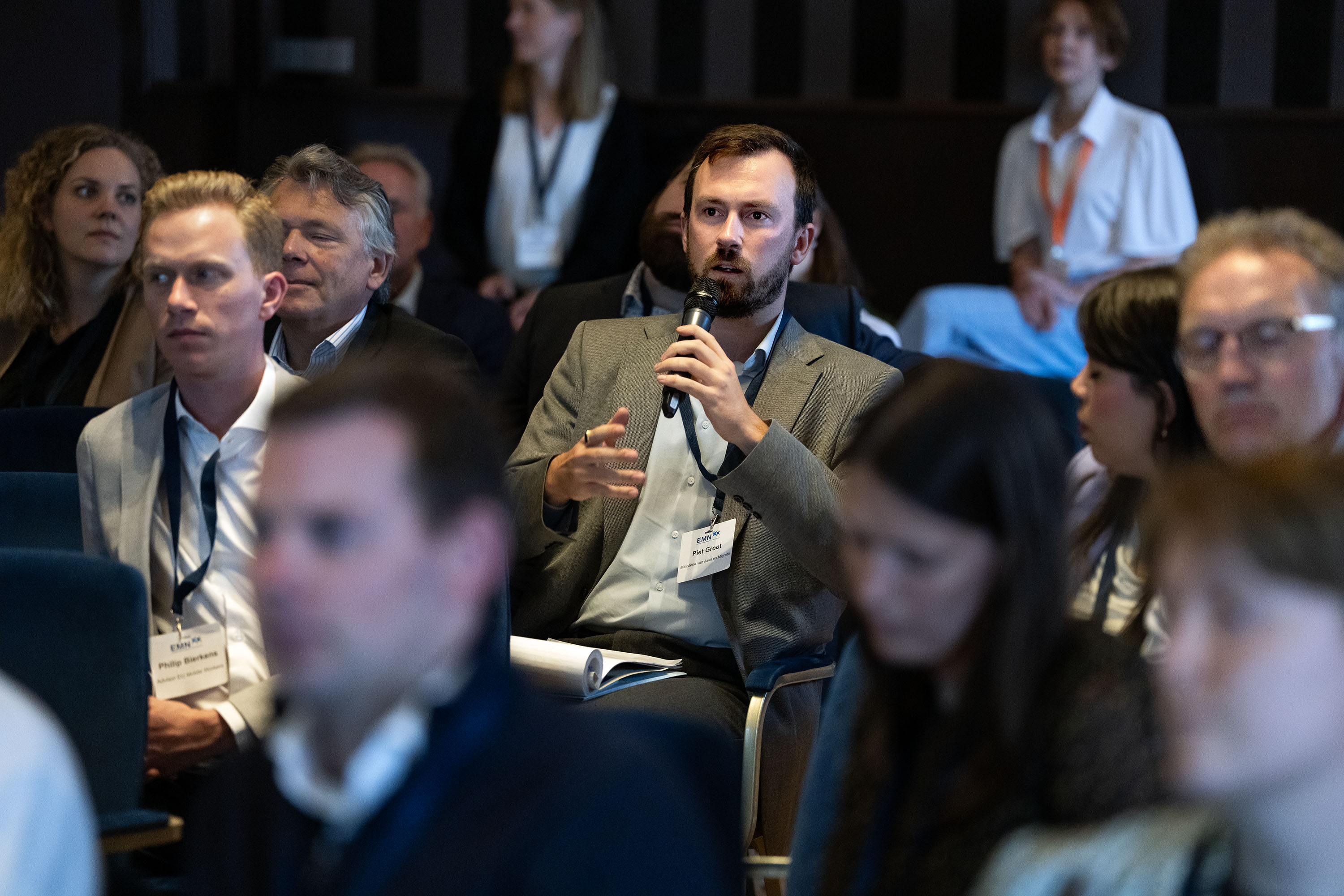 ted workers might benefit a lot, but lower skilled people might experience more negative effects of labour migration. It will have to be very well designed and selective if you want everyone to benefit.’ Telma Brito Martins reacted by stating that ‘the EU is already doing this in a way in the design of the policies. The EU has several directives in place providing for a comprehensive approach on migration.’ With regard to the ‘triple win’ Jean-Christophe Dumont mentioned that ‘the most challenging is the benefit for the country of origin. It takes more to make it a win for these countries. Circular migration is used as a mantra, but this is a solution only for seasonal work. Most of labour migration has a permanent component. So basically, the only way to make it work is to train more people in the country of origin. Businesses have to be involved in the design of training. So the question is: how can you involve employers? There is one elephant in the room: employers do not trust that this will lead to them getting the people they want. You have to show them that if they invest, they will get a return on investment.’ Telma Brito Martins mentioned that the private sector is already being involved for instance in the Talent Partnerships which aim to create mutual benefits. ‘There are some projects in place, such as in Tunisia a project aiming at training at least 800 Tunisian technicians in the plastics sector in France and for 400 to participate in the permanent mobility is directly implemented by Polyvia. The idea of circular migration is a way of mo
ted workers might benefit a lot, but lower skilled people might experience more negative effects of labour migration. It will have to be very well designed and selective if you want everyone to benefit.’ Telma Brito Martins reacted by stating that ‘the EU is already doing this in a way in the design of the policies. The EU has several directives in place providing for a comprehensive approach on migration.’ With regard to the ‘triple win’ Jean-Christophe Dumont mentioned that ‘the most challenging is the benefit for the country of origin. It takes more to make it a win for these countries. Circular migration is used as a mantra, but this is a solution only for seasonal work. Most of labour migration has a permanent component. So basically, the only way to make it work is to train more people in the country of origin. Businesses have to be involved in the design of training. So the question is: how can you involve employers? There is one elephant in the room: employers do not trust that this will lead to them getting the people they want. You have to show them that if they invest, they will get a return on investment.’ Telma Brito Martins mentioned that the private sector is already being involved for instance in the Talent Partnerships which aim to create mutual benefits. ‘There are some projects in place, such as in Tunisia a project aiming at training at least 800 Tunisian technicians in the plastics sector in France and for 400 to participate in the permanent mobility is directly implemented by Polyvia. The idea of circular migration is a way of mo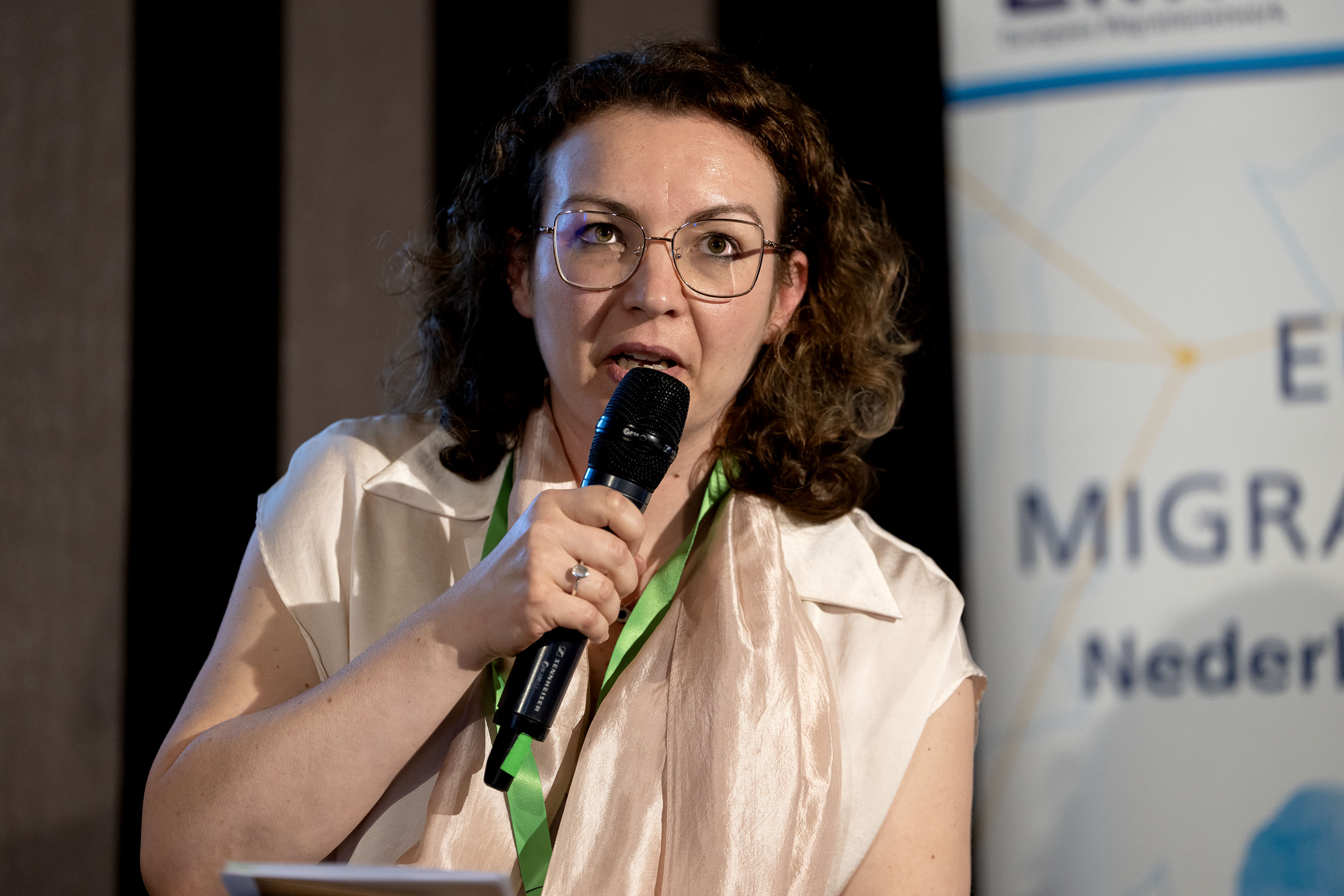 ving from brain drain to brain gain.’ Gijsbert Werner agreed that the most challenging party to ‘win’ is the country of origin. ‘The priorities of a lot countries in EU are the same: aging, etc. Benefits of labour migration will become clear also for countries of origin who experience population growth – they won’t have sufficient jobs in the future.
ving from brain drain to brain gain.’ Gijsbert Werner agreed that the most challenging party to ‘win’ is the country of origin. ‘The priorities of a lot countries in EU are the same: aging, etc. Benefits of labour migration will become clear also for countries of origin who experience population growth – they won’t have sufficient jobs in the future.
3| Cooperation with non-EU/EFTA countries (third countries) are needed in order to prevent irregular migration and expanded labour migration opportunities are an essential element for this.
Telma Brito Martins said ‘labour migration strengthens cooperation with countries of origin. Engaging with third countries is essential.’ ‘In general,’ Paul de Beer reacted, ‘labour migration and irregular migration are not substitutes. But of course, partnerships with third countries might work. But I question what will happen to the irregular migrants who have to stay.’ Jean-Christophe Dumont said that ‘there is only one way to address irregular migration, and no country is doing this: fight illegal employment. If you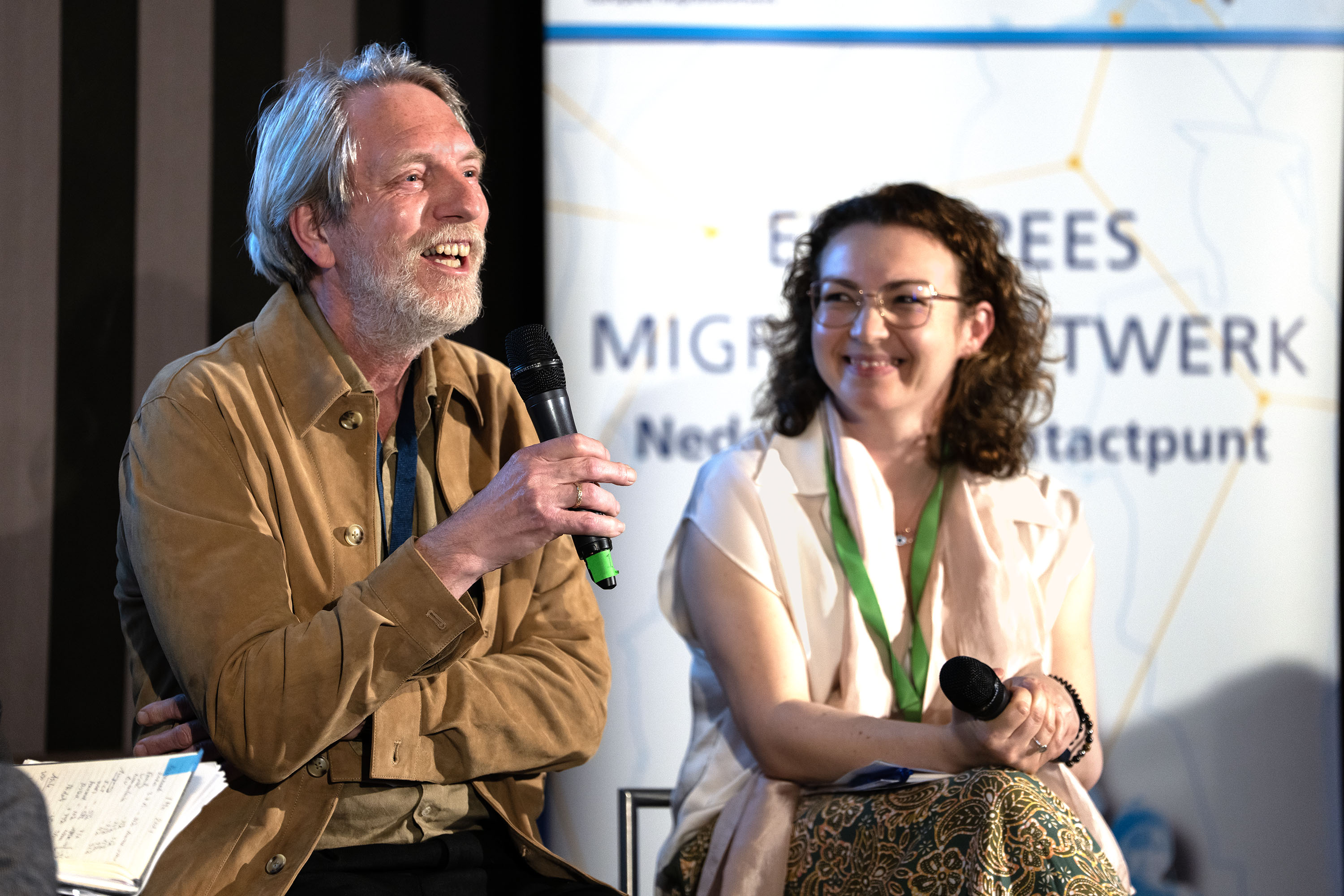 drive it out, it will disappear. Political cooperation with countries of origin is possible, but the numbers we put on the table often do not meet their expectations. We need to make sure there is something in the deal for them to.’
drive it out, it will disappear. Political cooperation with countries of origin is possible, but the numbers we put on the table often do not meet their expectations. We need to make sure there is something in the deal for them to.’
To close, Desiree Hoving asked the panel members what they would you like to see in the future. The key thing Gijsbert Werner said to take away after hearing various approaches was that ‘we have to be aware that we need all (productivity increases, innovation, labour participation and migration). They are not substitutes. The shortages will be very challenging. We will need all of the approaches.’ Jean-Christophe Dumont fully agreed, but added that ‘labour migration from outside the EU is the only migration category we can set to zero tomorrow, if we want. So first, you have to know and be able to explain: why do you want labour migration? Is it a demographic issue? Is it for innovation? For shortages? We have a design problem. You have to decide what you want. Then propose it to the voters. People don’t trust migration policy makers because they have seen many failures in the past. We have to set the objective, and then show the results.’ Paul de Beer took this argument further by stating that ‘we shouldn’t even start the discussion with the topic of labour migration. We should decide: what kind of economy do we want to be, given the challenges of aging, etc. If you start from labour migration, you are thinking too small. I would be great if this – the economy we want – can be the central issue for our next elections.’ Telma Brito Martins concluded by stating that ‘the Commission will continue working on this very hard, we are already doing that and have several initiatives in place. EU competitiveness is important. Migration management, including legal migration and integration are part of the tools we can use to ensure competitiveness and social cohesion.’
Key takeaways: Political reflections and lessons for the future
For the final session of the conference two Members of Parliament were scheduled to appear on stage. Unfortunately, due to unforeseen circumstances, Anne-Marijke Podt, Member of Parliament for D66, was not able to attend the conference.
Thierry Aartsen, Member of Parliament VVD, was invited on stage to share his political views. ‘For too many years,’ he stated, ‘we have had discussions about what is the problem, asylum or labour migration. I think there is to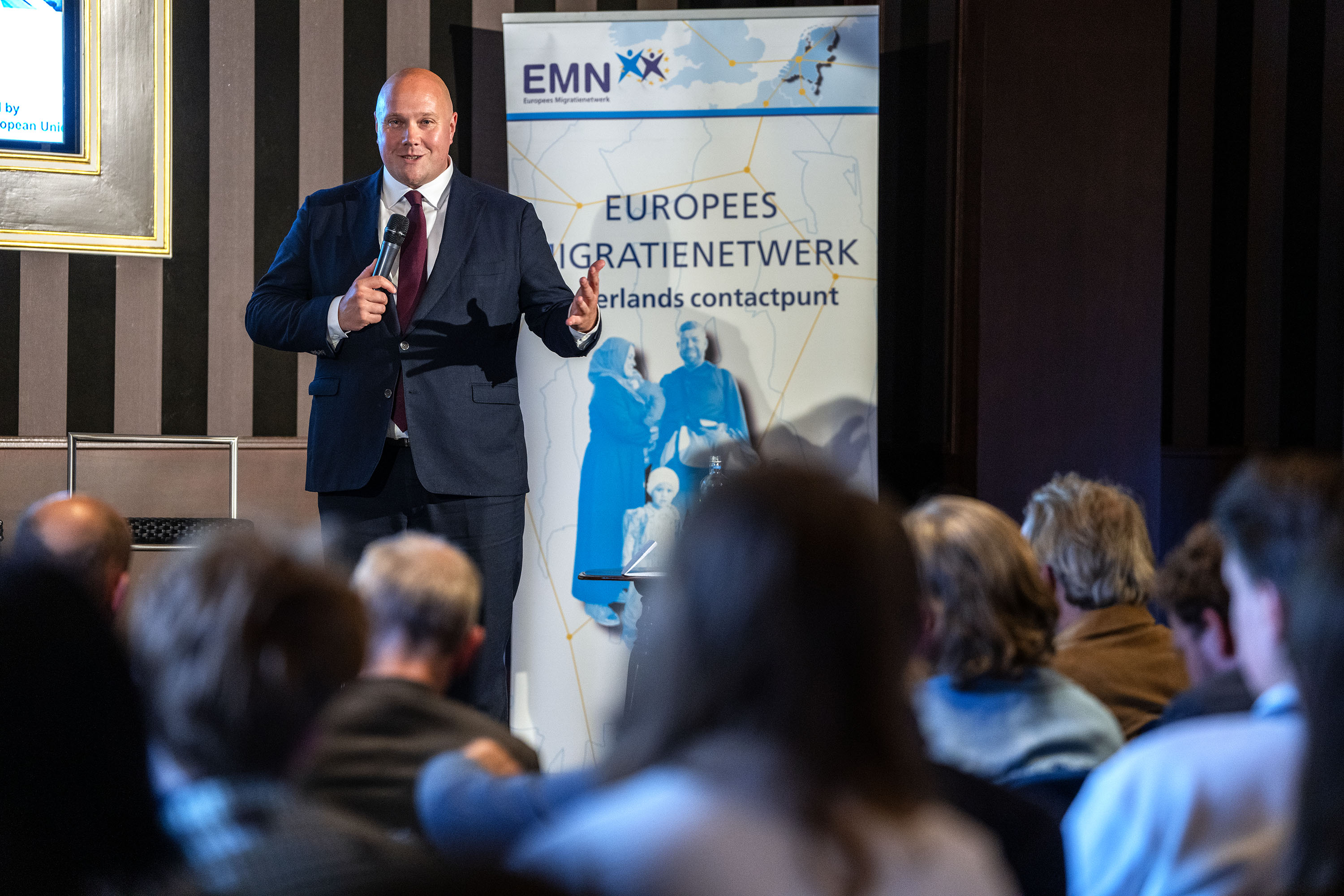 o much migration in total. It puts lot of pressure on Dutch society. We need innovation to face the aging, not more people.’
o much migration in total. It puts lot of pressure on Dutch society. We need innovation to face the aging, not more people.’
Reacting to the statement that ‘Labour migration from outside the EU has to be a central pillar of any future policy to address labour market shortages’, Thierry Aartsen said ‘I am not in favour. We should be very selective who we invite. We are a very attractive country. For migrants from outside the EU we can be selective. From inside it is of course more difficult. But you can introduce regulation and incentives. That’s the way to go. You are seeking incentives for innovation.’
When asked, by the audience, if raising minimum wage could be a solution, Thierry Aartsen responded: ‘this is not a good idea. It is much more effective to introduce taxes or other financial incentives.’ Another question posed by the audience concerned investing in the education of labour migrants that are present, and if employers should support that. Thierry Aartsen said that ‘Yes, we need to put the question of integration on the EU agenda. We see a lot of neighbourhoods in the Netherlands where there are only eastern Europeans, and that gives tension. We must seek solutions for this.’
Reacting to the statement that ‘the Netherlands will soon need targeted policies for attracting labour migration for strategic sectors’, Thierry Aartsen said he was ‘hesitant on this one. More migration is not a solution, because of the pressure on society. On the other hand, we have a tool to be more selective about people from outside the EU. You can focus on specific categories. But we have learned: when you open the door… There should be a hesitation to open it.’
A member in the audience raised the question of other EU countries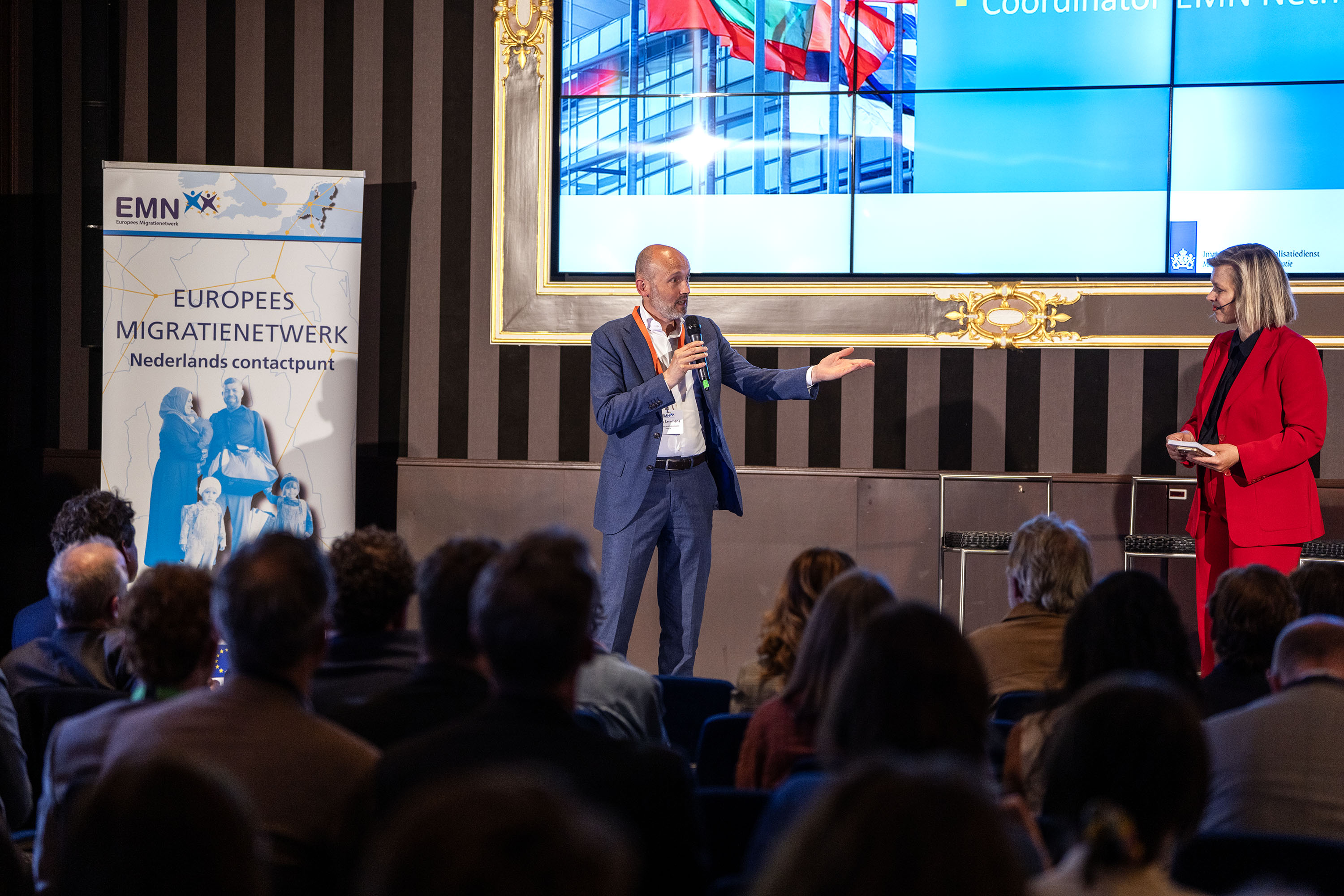 that are actively recruiting highly skilled researchers from the US. Shouldn’t the Netherlands compete for this. Thierry Aartsen stated that, according to him, ‘The Netherlands has a different position than other countries in Europe. We have to be aware that our position is lonely and the world around us has other problems.’
that are actively recruiting highly skilled researchers from the US. Shouldn’t the Netherlands compete for this. Thierry Aartsen stated that, according to him, ‘The Netherlands has a different position than other countries in Europe. We have to be aware that our position is lonely and the world around us has other problems.’
Hans Lemmens, coordinator EMN Netherlands, closed the conference.
Photos: Kick Smeets
